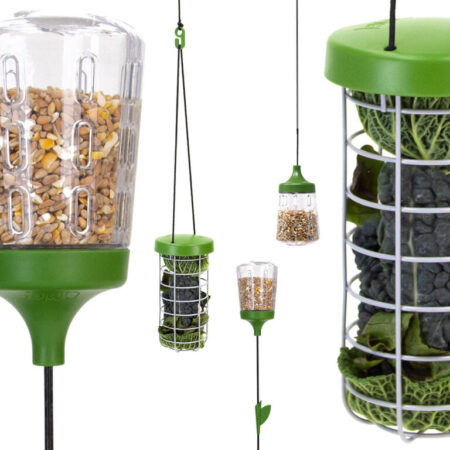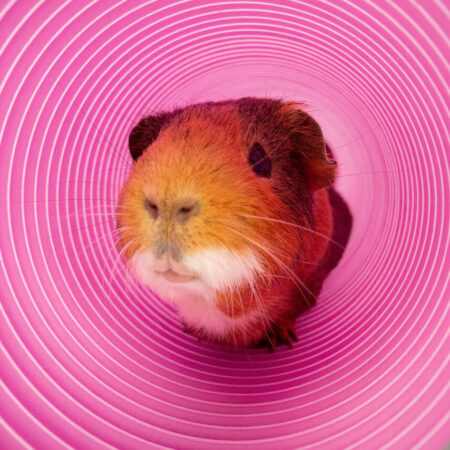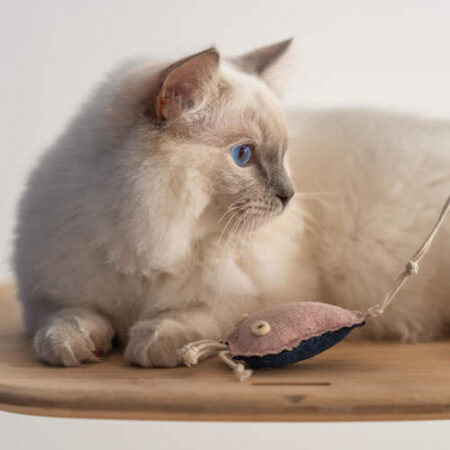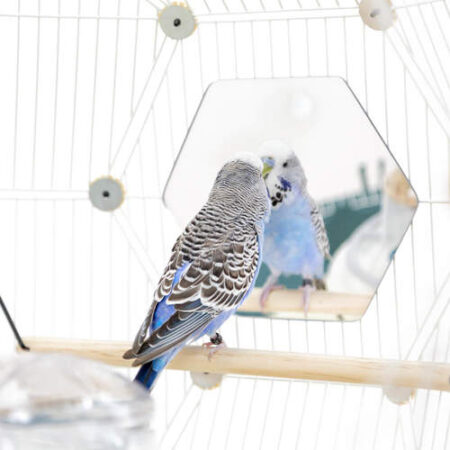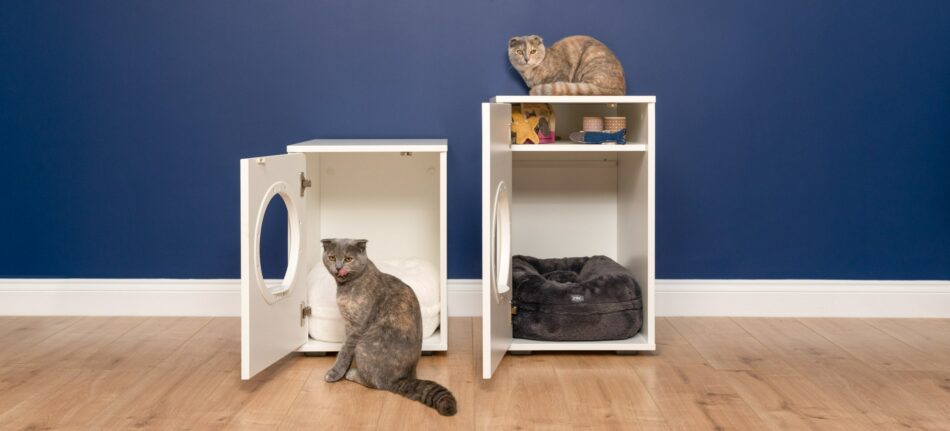
Does your furry feline peacefully snuggle up next to you in bed or insist on sleeping on your pillow? Or do you have a designated spot for your cat to claim as their own, yet they still prefer the back of your sofa? There are pros and cons to sharing your bed with your cat, and even though a bit of bed-hopping might be fun, having your own place to rest your sleepy head can’t be a bad thing. In this article, we’ll explore some kitty-approved places and find out where to put a cat’s bed.
Your cat’s perfect bed
The Maya Donut cat bed offers the perfect place for your cat to relax, and with a plush, faux fur finish, it’s completely irresistible. Plus, its easy-to-clean removable cover means a hygienic home for you and a clean sheet feeling for your cat. It comes in a variety of beautiful colours to suit any boudoir, too. Choose to have it without feet so you can place it inside your Maya Indoor cat house – a modern and stylish piece of furniture that can be placed anywhere in the home. The cat house acts as a sheltered and cosy spot so your cat can snuggle up and have a peaceful snooze away from the hustle and bustle of a busy home.
Likewise, a few felines really like to rest high up, so for the more intrepid explorers, you may find your cat has more of a head for heights and likes to be well out of the way and off the ground. In this case, you can accommodate this personality with an incredibly versatile Freestyle floor to the ceiling cat tree. As a customisable piece, you can add whatever you want to make this a fun entertainment and napping zone all in the comfort of your own home.
Where to put a cat’s bed
Resting is a fundamental part of a feline’s life and they give plenty of time to it. Cats ordinarily pick their most loved snoozing spot(s) themselves and it can be challenging to encourage them to choose somewhere else. To expand the possibilities of your feline utilising the bed you have picked, you can at least ensure that it is set in a peaceful spot, away from any drafts. A warm spot, close to a radiator or in the sun, is typically great and should get the seal of approval.
Choosing to have your cat’s bed in a specific spot not only provides them with security, but also gives you peace of mind knowing that they are comfortable, and hopefully where they should be. That’s not to say that the odd sleepover in your bed won’t happen though!
So, where do you put a cat’s bed that ticks the boxes of these very selective customers?
Here are a couple of suggestions, recommended by cats for humans:
- On your bed (with or without you in it)
- On the window sill, preferably south-facing
- In the utility room when the tumble dryer is on
- In the laundry cupboard on nice warm towels
- Curled up on my snuggly Donut cat bed
- Occasionally on your laptop
How much sleep does a cat need?
How long a cat sleeps and how often will depend on the age and personality of the cat. They are renowned for having mid-morning or afternoon siestas or it may seem as though they just sleep all day. Got a nice warm spot by the window? Then you’ll most likely find your cat there. Warmth and quiet are key to blissful nap time. Cats on average spend 12-16 hours per day snoozing, so that spot has to be right. Most of us envy cats who always seem to find the most comfortable place in the house and can sleep most of the day, and while we’re working or doing chores our cats always find time to enjoy a peaceful slumber. Cats can grow irritable and restless if they don’t get enough sleep (a bit like their pet parents). This could be because their bed isn’t in the right place and they are not comfortable.
Sharing your space
Occasionally sharing your bed with your favourite snuggle puss is no crime! In fact, most cat owners will have done this once or twice. Cats definitely benefit from being close to their pet parent and the feeling is mutual. It secures a bond and provides companionship.
Most cat owners know that cats are more active at night, even though they love to snuggle up to you to start with. Once they’ve had enough sleep there is always a possibility that they will pounce when your foot twitches or will come and plonk themselves on your pillow right next to your head. Even though it’s adorable, it can lead to a sleepless night (for you).
Creating an area in your bedroom for your cat could be an option, so that if they do become a little more active or start fidgeting they can always relocate themselves to their luxury cat bed that’s so soft you’ll want to curl up on it yourself – ideal for the pampered puss.
Where not to put a cat bed
A cat will not be very forgiving if you place its bed in a cold or damp spot. You should also make sure that it’s away from potentially drafty windows or a particularly noisy spot. For example, if your living room or kitchen faces a high-traffic zone, then this will not be favourable to your kitty and they will most likely seek out somewhere more quiet to rest.
Don’t shut them away
You may have a house full of pets, children or antique furniture in which case you might be tempted to shut away your cat at night. This isn’t recommended, given that they are most active at night, this is valuable playtime for them. It doesn’t mean they should roam the house completely rogue, but allowing them some space to explore is important to their development and ultimately their happiness.
Omlet and your cat’s bed
Providing your cat with their own space is key to stability, space and a routine that your cat is happy with. Having favourite napping spots is perfectly okay and your cat will undoubtedly choose their own whether you like it or not, but knowing they can call a place a home of their own with the Maya Donut cat bed and Maya indoor cat house will make them perfectly happy and adjusted. A stable home environment is paramount to your cat’s happiness, you can read one of our recent blogs Why do cats run away? which outlines the importance of a peaceful and secure home environment.
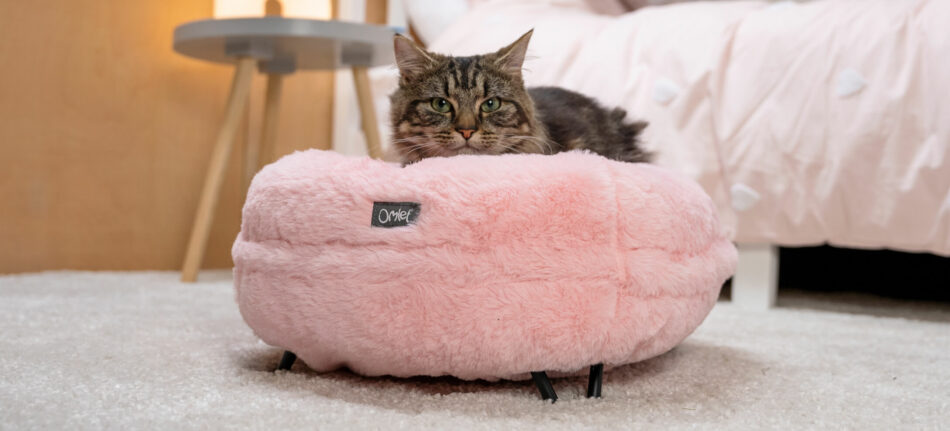
This entry was posted in Cats
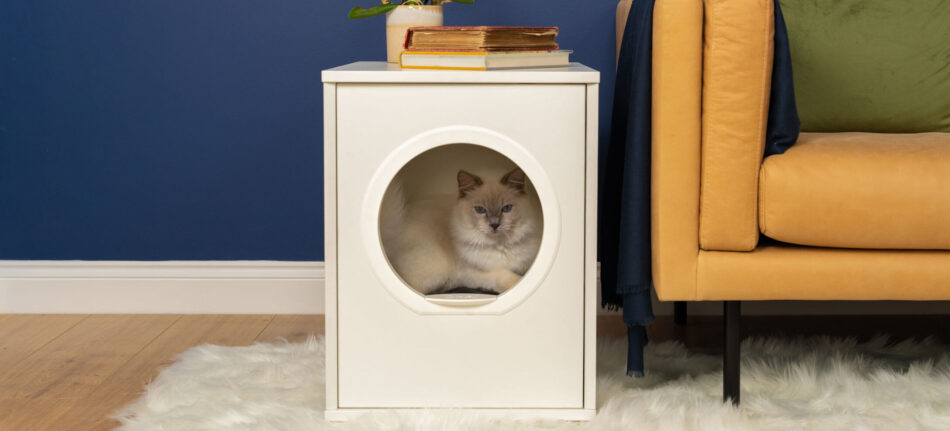
Whether your cat is moving with you to a new house or you’re welcoming a new cat into your life, a new home can be stressful and confusing for our feline friends. The first few days are especially trying, and it’s important that you as an owner do everything you can to make the move as smooth as possible for your pet. Read on to find out some top tips for moving with cats.
Moving to a new place with a cat – before the move
If you are moving with a cat, try to keep the cat’s routine as normal as possible in the days leading up to the move. Very anxious and timid cats will benefit from familiarizing themselves with cardboard boxes around the house before you start packing your belongings.
In the new house (or your current home if you’re rescuing a cat), prepare a room somewhere where you can keep your cat when you arrive. This should ideally be a spare room or a bathroom away from the hustle and bustle of the home. Cats will naturally think a new house is scary and smells unfamiliar, so giving them a smaller space to get familiarized with to start with can be less difficult.
Give your cat places to hide in the room, as well as a snug spot to relax, maybe with something they already feel comfortable with, like their super comfy donut cat bed or a blanket from the rescue centre. Also prepare a cat litter box, bowls with food and water, and some toys.
A Freestyle cat scratching tree that is tall and rigid will also help your cat let off some steam and allow them to leave familiar scents from glands in their paws, which will help them keep calm.
If possible, prepare this room with everything your cat needs before bringing them home.
During the move
The most important thing when getting a cat to settle in a new environment is to have patience and always let your cat make the first move when it comes to approaching new things, or new people. Most cats love feeling in control, and by pulling them out of the cat carrier or picking them up for a cuddle you could be adding to your cat’s stress.
Be aware that it might be a few weeks, or even months, before your cat feels comfortable in their new home. It takes them time to get used to new surroundings, not to mention other cats or children they’ve never encountered before.
If possible, it’s good to give your pets something familiar that makes them feel safe. If you’re adopting a cat, ask the adoption centre if they have a blanket or toy your new addition has been using, or if you’re moving house with your resident cat, unpack their things first. Don’t change the food you’re giving them, give them a new litter tray or treat them to a new bed just yet.
How to introduce cat to new home
Make sure the space where your cat is allowed to be is completely cat proof. This might, to start with, just be one room, but if you’re letting your feline friend explore the whole house, keep all doors and windows closed, and check potential cat flaps or even chimneys before you invite your cat in. Give everyone around on moving day careful instructions or put a sign on doors to inform them where the cat is. The new home will seem like an unsafe space for your pet, and their instinct will most likely be to escape.
Once you have set up a room or an area for your cat to initially settle into, carry the cat into the room and open the door to the cat carrier. Sit back and see what they are doing, but never force them to come out or pick them up, let them explore in their own time. You can sit in the room, or you can leave for a bit and come back later.
When you have seen that your cat is comfortable in their room you can open the door and allow them to come into the rest of the house whenever they feel ready. Cats are naturally inquisitive, so they will want to explore their new surroundings.
If you have other animals or pets in the house that your new cat has not met before, make careful introductions i.e. initially using a barrier, keeping a distance. You should try to space out any stressful events to not overwhelm your cat.
It’s normal for a new cat, or a cat in a new home, to not have much of an appetite or to cry during the first few nights. Unless you think it might be detrimental to your cat’s health, or that they are in danger, leave them to it. Most cats will stop this behaviour after a couple of days.
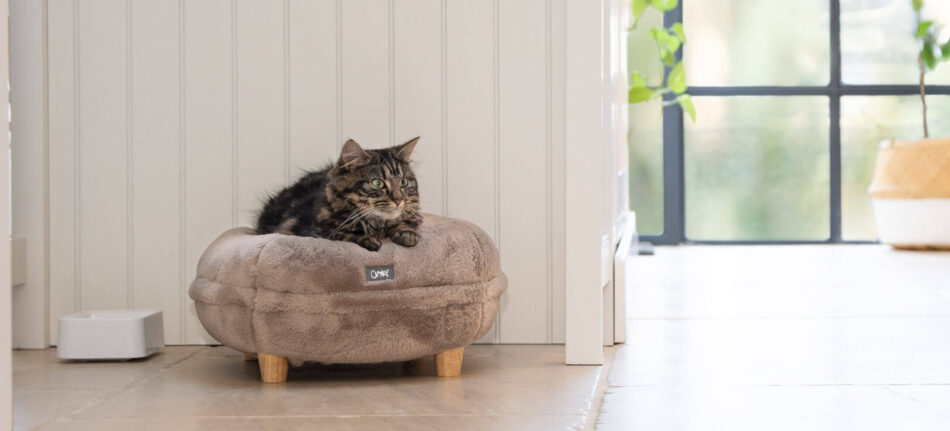
Transporting your cat to a new home
Make sure you have a good pet carrier that is big enough for your cat. If you can, it’s a good idea to get your cat used to car rides before the journey to a new home, but that is obviously more difficult if you’re picking up a rescue cat.
Put some soft bedding in the carrier and secure it in the trunk or with a seat belt inside the car. It’s important that it’s safe and doesn’t move around, as that will be very stressful for your cat. Regulate the temperature in the car so it’s cool but not cold.
Keep the journey as short as possible; don’t make any unnecessary detours or make stops you don’t have to make. If you do need to stop, it’s often best not to let the cat out of the carrier, as there is a risk they will escape. However, never leave your cat unattended in the car. It can quickly get dangerously hot, fast.
Moving a long distance with cats
If the journey is so long that you will need to stop and allow your cat to go to the toilet or eat and drink, it’s important you find a place where it’s safe to do so. Consider keeping your cat on a lead, or only let them out in a confined space. If you’re travelling really far you might want to sedate your cat to make the journey less stressful for all. Speak to your vet to see if this is an option.
When to let your cat outside
If you have a cat that normally spends a lot of time outdoors, you might want to let them out as soon as possible and give them their freedom back, but it’s generally good to keep a cat indoors for at least a few weeks. Moving is one of the most common reasons cats disappear, be it because they don’t feel safe in their new house or that they get lost, so be careful. You can read more about this in our previous blog post Why Do Cats Run Away?
Moving house with an outdoor cat
While keeping outdoor cats indoors, make sure they have plenty of stimulation and exercise opportunities.
Once you think your cat is ready to go outside, one thing you can do in preparation is to sprinkle a bit of used litter around the perimeter of the yard. This will make the outside space smell familiar to your cat, and other cats in the neighbourhood will be warned that there is a new cat on the block.
The first times you let your cat out, make it short, and keep an eye on them. Call them back after a few minutes, and gradually extend the time they spend in and around the yard. It’s best to stay with them to reassure them that everything is fine, and leave the door or cat flap open so they can return into the house if something scares them.
If you have moved somewhere that doesn’t allow your cat to roam as freely as they have previously done, be it due to traffic, wildlife or neighbours, you might want to consider investing in an Outdoor Cat Run. Omlet’s catios lets your cat feel the wind in their fur in complete safety, and they can keep your cat healthy and fit without the worry of them running away or getting hurt. There is also the option of a Cat Balcony Enclosure if you live in an apartment.
Moving house with your cat
While lots of these tips apply to a new cat as well as a long term pet who is moving with you, there are some specific things that could help a current cat settle in.
As your cat has been living with you, there are things that will be easier than bringing home a new cat. Maybe they have a Maya Indoor Cat House or Memory Foam Bolster Cat Bed where they can go for some quiet time and that will immediately make them feel at home. If you want to introduce your cat to a cat house, this might be a good time, as they will be searching for a safe space to retreat to. You can read more about this in our previous blog How to Get a Cat to Use a Cat House.
Depending on their personality, you will probably want to let them out of their initial introduction room quite quickly. They are used to being around you and your family and keeping them separate can be more stressful. But again, wait for them to make the move.
One thing to help your cat adjust can be to take a piece of cloth and rub it gently around your cat’s neck and face to pick up their scent. You can then wipe this cloth on furniture in the house at cat height to make the new territory seem more familiar. Feliway products or a pheromone diffuser can also be good options.
Remember to update the address on their collar and change their microchip information on any database.
If you haven’t moved far, there is always the worry that your cat may disappear in search of their old home. Sometimes the new owners will provide food and leave out water bowls for the unexpected visitor, so, if possible, ask the new residents to let you know if your cat shows up. To avoid these trips down memory lane, keep your cat indoors for the first few weeks after the move. That won’t necessarily make them forget their old home, but should get them used to their new one, and hopefully realize that’s where they belong.
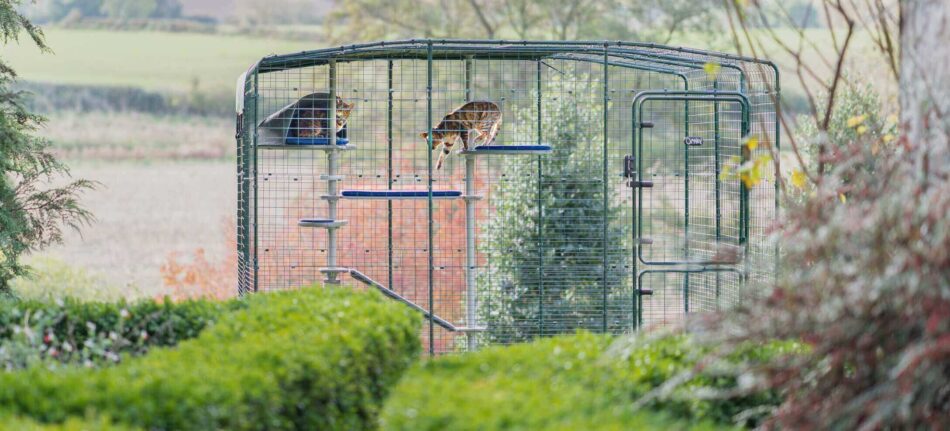
Moving with multiple cats
If you live in a multi-cat household, then this can inevitably make things a little bit complicated, but with the right preparations, the move can be made as stress free as possible! The process of moving itself isn’t all too different, but you will have to consider the needs of more than just one animal. Take a read of our How to Create Peace in a Multi Cat Household blog for some advice on creating a better dynamic between your cats, which will help in making the transition easier when the time comes.
Conclusion
A move is a very exciting event for both cats and humans, especially for those who are moving from a shelter to their forever home. However, most animals are creatures of habit, and many cats find a new house a very scary thing. To make the move a bit more comfortable, shop Omlet Cat Products to help you find everything your purry pal needs to settle into their new home. Make sure you prepare yourself for the next few days, or weeks, to be a bit tiring. And with these tips for moving with a cat, it will, of course, be worth it in the end!
This entry was posted in Cats

Common allergies in cats and dogs have been identified as 3 main allergy groups, which we explore in this article. Some common allergies are seasonal, and others can creep up throughout the year. Understanding the common allergies in cats and dogs will make being a pet owner easier as you know what to look out for and how to handle it. Allergies can be treated quite easily, but there are a few symptoms or warning signs that we can look out for to make sure that our cats and dogs are healthy and happy.
Persistent seasonal allergies such as the dreaded hay fever kicks in for many of us humans, but we know that we are not alone in this seasonal battle of the bugs as our beloved pets can suffer too. We exhaust alternative medications, home remedies and whatever we can lay our hands on to try and keep these pesky allergies at bay!
Despite doing our absolute best to ensure our cats and dogs are spoiled and looked after, sometimes we cannot always spot the potential threats of allergies or illness.
Allergies in cats and dogs fit into 3 main groups. These groups make it easier to be able to narrow down and identify the cause and then the form of treatment that is required. Whilst you may be able to “self diagnose”, (we all like to play doctor or vet with a quick google search), it is always recommended to check with your vet before attempting any medicated treatments yourself. However, a little research and a general understanding of what you could expect as a pet owner are perfectly normal.
Common Allergy Groups in Cats and Dogs
1. Flea Allergy
This is probably the most common allergy and one that most pet parents are aware of. Cats and dogs will react to the toxins in the saliva following a flea bite, which will result in a reaction on the skin.
Cats will over groom to the point where it’s very noticeable and the skin develops crusts all over the body, known as miliary dermatitis. Dogs tend to nibble and scratch at the affected areas and the skin will develop little red spots.
2. Food Allergy
Food allergies don’t necessarily show up immediately, they could manifest from eating the same food over a long period of time. It is a reaction to a specific protein or chemical in the food, which then appears on the skin. Common proteins which can cause allergies for both cats and dogs are chicken, fish, gluten and egg.
A common symptom of food allergies in cats will be persistent scratching around the head and neck. Symptoms in dogs are not as easy to identify but generally if scratching is more regular and your dog’s skin seems more irritated then it could be a sign of a food allergy.
3. Atopic Dermatitis
These are allergies caused by the environment, similar to hay fever or asthma in humans. They can be seasonal like an allergy to pollen or all year round, for example dust mites. With dermatitis, the skin will be visibly irritated and affected with symptoms including the following:
- Constant scratching in a particular area
- Flaky skin
- Red or irritated skin
- Overlicking
- Chewing
- Fur loss
- Patchy skin
- Skin rashes or spots

Should my pet see a dermatologist?
If you think your pet is suffering from an allergy with any of the symptoms mentioned, you will notice that the skin is affected. A dermatologist will try to recognise the cause of the skin irritation by discussing your pet’s history, for example diet, home life and behaviour. Once they are able to identify the correct allergy group they will be able to perform certain tests to pinpoint the exact cause and recommend any treatment or ways you can help.
Seasonal Common Allergies in Dogs
Seasonal allergies can affect your canine friends in very similar ways to humans. They could be affected by environmental allergens like dust mites, fleas, mould and pollens from grasses, trees, weeds, and flowers. They will not hide their discomfort and will most likely obsessively lick or scratch one particular area. Pay close attention to their bellies, paws, armpit, ears and face. During the seasons of irritation, keep your home as clean as possible and free of mites and pollen. The Topology Dog Bed provides a simple and stylish way to keep your doggy comfortable all year round with easy to clean removable and washable covers.
Seasonal Common Allergies in Cats
Cat allergies are not as common as they are for dogs, though some will display irritation from pollen or bites from fleas. If your cat sneezes a lot then it could have an allergy to pollens. As with dogs, it’s important to make sure their bed is kept clean. A good alternative is the luxury Maya Donut Cat Bed, which has a removable cover that can be washed in the machine.
Respiratory Allergies
Respiratory allergies are far less common in cats and dogs, but they can suffer from them. Symptoms are similar to those of a cold, including watery eyes, runny nose, coughs and yes, even sneezes! Some respiratory allergens could develop into asthma. This could occur from being in a smoky environment, building debris, chemicals or certain cleaning products or pollution.
Pets, like humans, benefit from fresh air, so taking dogs for regular long walks will always be good for them (and you). Whilst you may want to take your cat for a walk, maybe it’s time to consider an Outdoor Catio, which will not only provide a safe space for your feline, but it will also provide them with plenty of space to play and explore and generally keep fit!
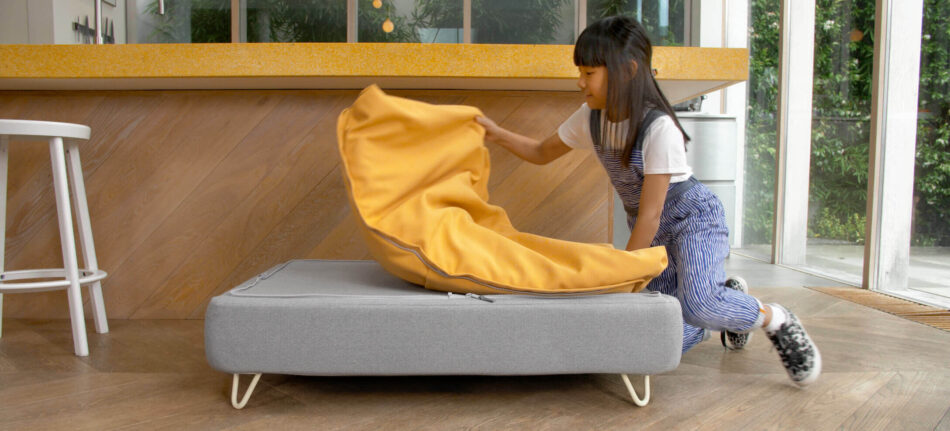
Conclusion
Being a pet parent comes with worries, but also plenty of love, laughter and snuggles along the way. Medically treating your cat or dog can be incredibly difficult to do because you don’t want to be the one that causes them any discomfort or pain, but sadly sometimes it is part of the job description and absolutely necessary to ensure they live a long and healthy life.
If you do suspect that your pet is suffering from any allergies, it is important to talk to your vet and run any concerns you have by them. Most allergies can be treated easily with medication, a change of diet or simple TLC. When dealing with allergies it is important to keep your cats and dogs home clean and you may need to adapt or change your routine to suit their needs.
This entry was posted in Cats
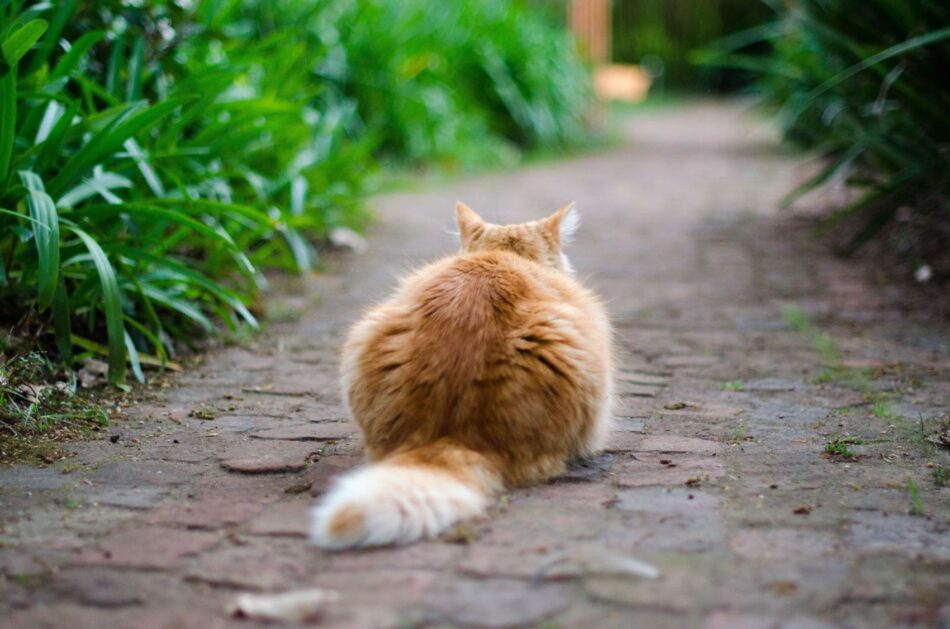
If your feline friend has turned your life into a frenzy and ran away before then you’re not alone. Cats are notoriously territorial, highly organised and routine-based, and are creatures of comfort and security. This does however not mean that they won’t abandon their home comforts if they feel the need for adventure or become distressed due to changes in their home environment. What are the main causes for our cats to run and turn curiosity into concern?
Possible Reasons why Cats go Missing and Don’t Come Back
Cats don’t just run away from home without a good reason. Indoor cats might be less likely to run because being outdoors isn’t something they are used to. Unfortunately, if something causes them to go outside and they get scared they could run out of fear and confusion. Outdoor cats might already be familiar with the perimeters of their homes, though there are many reasons why they too could run away. Here we look into various reasons why this could happen and what we can do about it if it does, so that our domesticated cats stay safe!
Your Cat was Scared
A cat’s disappearance can also be linked to fear. Indoor cats will have less access to the outdoors mostly for safety reasons or lack of outdoor space. They can be scared by loud noises, an unwelcomed visitor, for example a neighbour’s dog or something unfamiliar to them, and it doesn’t take long for your purrfectly happy pussycat to turn into a scaredy-cat. They certainly enjoy a peaceful environment and can often become quite disgruntled when that peace is disturbed. If their home life has become unsettled due to divorce, children leaving home or moving house their impulse could be to escape what may seem like a dangerous environment.
They’re in Season (or looking for a cat that is!)
This is something to watch out for, especially when female cats are on heat. When unneutered male cats get a whiff of a reproductive female there’s little you can do to distract him! It is not uncommon for cats to follow their mating instinct and they could disappear for days during this mating season.
As an owner of a female cat, it may be a good idea to keep them in during this time to avoid this dilemma and a few worried cat owners. Otherwise, ensure that your cats are neutered, which will diminish this instinct.
They were Stressed
As we have looked at some of the common, perhaps less threatening, causes for cats to run away, it is important to address the more serious reasons, which can be down to changes to the home environment and the stress that this can cause to our pets in general.
Cats are independent and can often be quite aloof and lead us to believe that they are pretty resilient, but this is not at all the case. They crave the security of home life, and whilst they’re not as dependent on us as dogs are, they love their human families and are very protective of them. As we spend so much time with our pets, they develop possibly more human characteristics than we realise. When our lives become unsettled, so do theirs. Take the time to explore cats and stress, why it happens and how to spot it.
Cats do suffer from separation anxiety, which may be more apparent as we emerged out of various lockdowns and headed back to work. If the home routine changes, cats will notice and can often become very distressed. This could lead to some more challenging behaviours, however, running away is unfortunately also very common as a result of stressed home life.
They’re Cheating on You
If you’ve noticed that your cat has put on a little weight, it’s not unlikely that an overly friendly neighbour is feeding them. Cats absolutely love being spoiled and they can be very sneaky and often get what they want. It’s unlikely that anyone would just allow a cat to be a permanent resident of their home without checking if they belong to anyone, but it’s best to be on the lookout. If you become aware that this in fact is happening, just have a polite word the person(s) in question and stay one step ahead of your greedy pussycat.
You Didn’t have an Outdoor Catio
Allowing space for your cat to challenge itself and play is really important. At Omlet we have developed our Omlet Catio range, which provides a safe and secure place to do just that. Conquer the curiosity in your cat’s personality, let them climb, hang, balance and relax as if they were out in the wild. This way you can entertain your cat’s natural instincts and keep them safe at the same time.

Natural Predators
Cats are determined hunters and once that animal instinct kicks in they can go for miles, extending their hunting perimeter. It is possible that they become so distracted pursuing their prey that they get lost! More often than not, they will return, perhaps rather hungry and slightly embarrassed that they managed to get lost in the first place!
Disease, Injury or Death
Outdoor cats are more prone to sickness and injury than indoor felines. That could be due to infection from ticks, fighting with other cats, poisonous plants or food. For this reason, your cats are safer in an outdoor cat run so you know where your feline is at all times.
If you’re concerned about your cat once they’ve returned from a stint in the great outdoors, it is recommended you take them to the vet immediately to get them checked over.
In a desperately sad situation, and one we don’t like to think about, some cats will wander off to die. A senior cat who knows they are nearing the end of their life may wander off to be alone. Cats who are very unwell, often hide away and some will not return. If you do have an elderly cat or one that’s unwell then, it’s important to make sure they stay warm and comfortable. So, what are the best ways to keep your cats warm? Pay attention to your cuddly companions, because after all that is what they are, companions, and you want to make sure that they are looked after in the best way possible.
Picked up By a Moving Vehicle
Wandering cats may find themselves in a tricky situation if they end up creeping into an open car or delivery van and falling asleep! Given their size, they could easily go unnoticed until much later. A more worrying or unimaginable reason would be that they have been catnapped. Sadly they could easily be picked up by someone and they wouldn’t be able to give that much of a fight. Your cat’s safety is important, and given all these external factors and fears it is recommended that your cat is microchipped, even if you have an id tag on your cats collar. That is is better than nothing, but it’s worth noting collars can also impose a risk to your cat’s safety when climbing trees or getting stuck in bushes.
What Should I Do if My Cat is Missing?
If you have a missing cat try not to panic. Despite feeling helpless, scared, and worried it is important to get on the case and take action as soon as possible. There are multiple reasons why cats run away or wander off, and more often than not they will return, but it’s always best to be prepared. Whether you have an indoor cat or a predominantly outdoor cat who often roams freely, finding out they have gone missing is a frightening experience. Get as many people as possible involved in the search and contact a local shelter or vets so that they too can keep an eye out.
Don’t Beat Yourself Up
As a cat lover, you would naturally be devastated if your cat runs away. You have probably done everything you can to provide the most comforting home for your furry friend, but cats do sometimes run away, and it’s won’t necessarily have been your fault. So try not to be too hard on yourself! If you can identify why your cat may have bolted it might help work out how to get them back.
Post on Local Facebook Groups
The internet is full of animal lovers and can be a very useful resource in a situation like a missing cat. Post an up to date photo and description of your whiskered friend in some local Facebook groups, this way you’re increasing your chances of finding him/her. Someone may have spotted your lost cat, which may give you a clue as to which direction they have gone in!
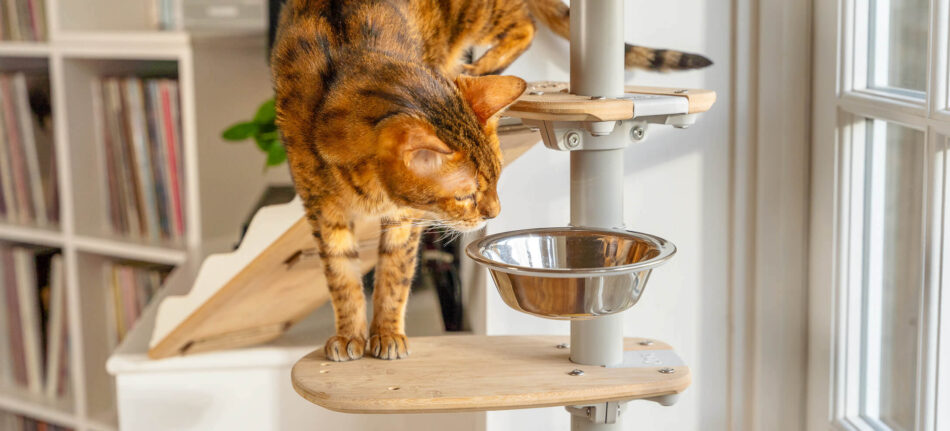
How Missing Cats Find Their Way Home
Most cats are capable of finding their own way home to their cat parents. Our animal’s ability to retrace their steps even after a few days following the scent of an unneutered male or female cat or chasing after prey is part of their natural homing instinct. So if you’re a cat parent to a runaway cat, don’t jump to the worst conclusion. There is always a possibility that they will return.
If you have recently moved house a cat can potentially try to find their way back to its previous home. It has been reported that cats can travel hundreds of miles over the course of a few months if necessary, just to get back to what they think is home. It’s not recommended to let your cat out when you first move, because they need to get used to their surroundings first. You can attempt to use a cat lead, which isn’t always straightforward. Cats, unlike dogs, aren’t particularly keen on being “walked”. Another suggestion is to carry your cat around the garden or down the driveway or road so that they can become a little more familiar with the perimeters of their new home.
Their Favourite Treats Were Left Out
Domestic cats love being spoiled and they enjoy a treat or two! Leaving some of their favourite Cat Treats out may well entice them back after their recent wanderings.
They Missed You
Not all cats run away from home on purpose. It is likely that something caused them to run. Your relationship with your pussy pal will have a big impact on how they feel about you. Cats are often treated as a family member and they recognise that, so they will miss their cat parents after a while and crave the comfort of home life soon enough.
They Decided to Come Back
After the mini-adventure, they might realise that being away from home isn’t that great and will just return by themselves! The prospect of a nice warm lap to sit on or the pleasures of their own Maya Donut Cat Bed will beat staying out in the cold and having to fend for themselves. Cats are independent beings, but they are guilty of wanting human interaction and creature comforts.
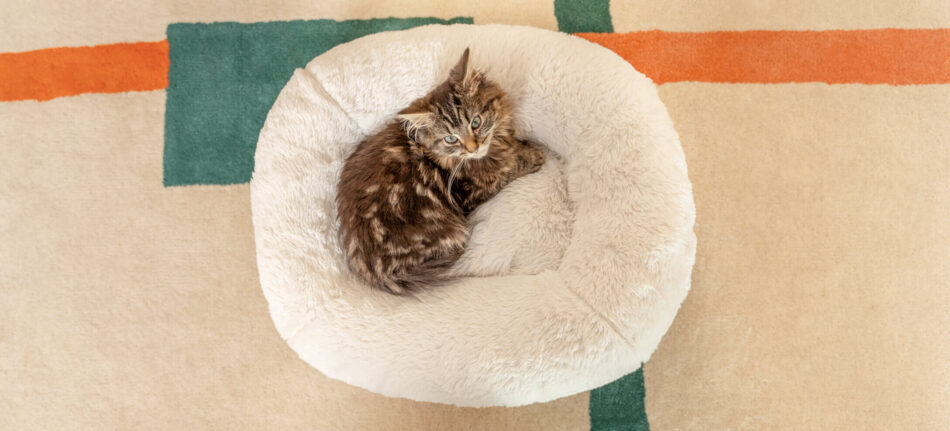
Why Do Cats Run Away from Humans?
Despite your best efforts cats may feel a bit neglected due to changes in your life such as a more demanding job, a new partner or a baby, which would naturally require more of your attention. You may have less time to devote to your kitty, which can make them look for attention elsewhere. A cat’s personality craves attention and play, and even though they may act like they don’t need their cat person, they really do.
Make sure that you dedicate some time to your cat, and why not provide them with a Freestyle floor to ceiling cat tree which is an excellent source of entertainment and exercise, especially if you are perhaps a little busier than usual. Your cat will thank you!
Humans are Much Bigger and Can Seem Intimidating
Cat owners naturally adore their pussycat pals and would do almost anything to protect them, however, it’s worth taking into account not all humans feel the same, with some even being afraid of cats. Many cat parents will be recognisable to their kitty babies but they may feel a little intimidated by humans they have not come across before. Cats can certainly pick up on any negativity from humans that might not be so welcoming to a small four-legged furry friend.
You Might’ve Been too Rough with Them
Cats are not as tough as they might seem, and remember, they are only small creatures! Your strength could be overpowering to them and frighten them. So when you are playing with them, be careful that you’re not too rough! When there are small children around, it is important to keep an eye on how they behave around cats, especially if they don’t have any of their own. Children might not understand how to play and often tug at the tail, which certainly will not impress our furry feline.
How Can I Stop My Cat from Running Away from Me?
Take into account your current home life and any changes, whether there are other animals to contend with or new humans to get used to. Cat’s don’t like to feel second best, so there are feline aids that will make them feel extra special, like the Luxurious Maya Donut Cat Bed that will leave your kitty feeling like a king or queen. It is important to build a good relationship with your cat and understand their unique personality.
Build Trust
Whether you bring up your feline from a tiny kitten or take in a shy rescue cat, your relationship with them as the primary caregiver needs to be consistent. The trust between this small creature and their cat parent is fundamental to their happiness, and ultimately yours too!
Positive Reinforcement
Reward your kitty cat whenever required to do so, because knowing that they are loved will reinforce their desire to stay with you and not try to escape if the moment presents itself.
- Entertain your cat with fun and stimulating cat toys by exploring the fun side and predatory behaviours rather than trying to diminish it
- Provide more accessories to their customisable Freestyle cat climbing frame
- 2 legged human companions respond well to the occasional promise of chocolate or sweets and that includes cats! Reward them with some tasty cat treats
- Love, lots of love! Shower your cat in love, which will ultimately be the best reward ever!
Create a Safe Space
In a potentially unsettled environment, if you have moved house, welcomed a new member to the family or have suffered a loss within the family your cat will feel this unsettled feeling in the same way. Make sure you provide a safe and secluded space for your cat, like the Omlet Maya Indoor Cat House, which gives your pussycat a super snuggly cosy house away from any disturbances. Introducing your cat to a new house might take a little time, but we can help you get your cat used to a cat house and they will be purring away with happiness in no time.

Conclusion
It is very important to provide a safe home for your cats and gradually get them used to a new routine if anything changes at home. Cats love order and change can cause them to feel stressed, scared or even unwanted. When cats feel threatened, they usually respond in three ways to the object, individual or circumstance: fight, flee or freeze. Sadly for us, cats running away from home is more common than we would like, and whilst the prodigal pussycat will often return when they please, it is important to be prepared for every possible situation. For peace of mind, ensuring that your cat is microchipped with up to date information is very important, and for the owners of indoor cats who don’t roam freely, give them the sense of the great outdoors and feed their curiosity with an outdoor catio, or a cat balcony enclosure.
This entry was posted in Cats
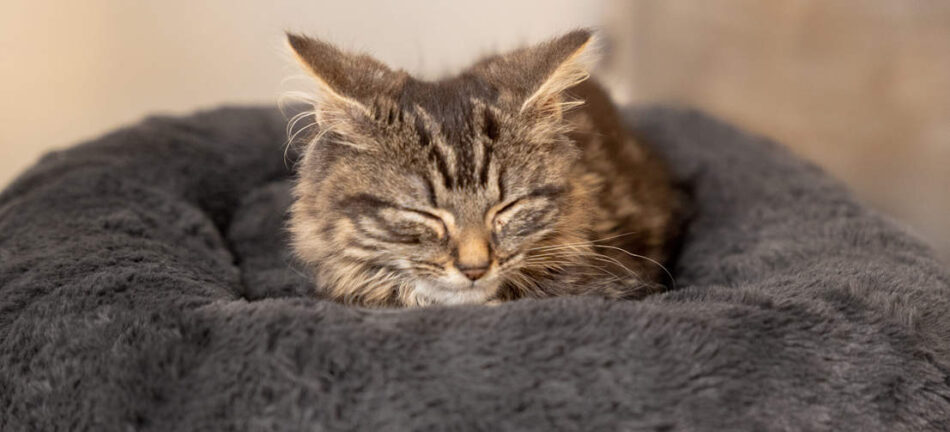
Have you ever taken a look at your cat’s whiskers and wondered why they’re there? Or why one cat’s whiskers are shorter than another’s? Read on to find out 10 things you might not know about cat whiskers.
1. Your cat’s whiskers can tell you how they’re feeling
Did you know that your cat’s whiskers can give you an insight into their emotions? A happy cat’s whiskers will be relaxed and slightly to the side, whereas a cat on high alert or hunting prey will have fanned out whiskers that are pulled forward. A fearful or shy cat, on the other hand, will try to make their face look smaller by pulling their whiskers back.
2. Cats are born with 24 whiskers
Cats are born with around a total of 24 mystacial whiskers – that’s 12 on each side of their face. This number will stay the same for the rest of a cat’s life!
3. Whiskers are connected to a cat’s nervous system
Whiskers are also called vibrissae, which means to vibrate. And because a cat’s whiskers are connected to their nervous and muscular system, this makes them highly sensitive. Therefore, when brushed against something, causing a vibration, whiskers will send signals to your cat’s brain to help them to navigate the world.
4. The world record for the longest cat whiskers is 7.5 inches!
In 2005, Missi the Maine Coon from Finland achieved the world record for the longest cat whiskers at 7.5 inches long! To put this into context, the average cat whisker only measures at around 3 inches. However, generally speaking, longer haired cat breeds do tend to have longer whiskers.
5. Whiskers can make cats better hunters
Whiskers can help a cat when it comes to hunting their prey. Initially, a cat’s whiskers will determine whether they will be able to squeeze into an enclosed space to make their catch. Their whiskers will then help them to identify the shape of their prey, allowing them to bite in the perfect spot.
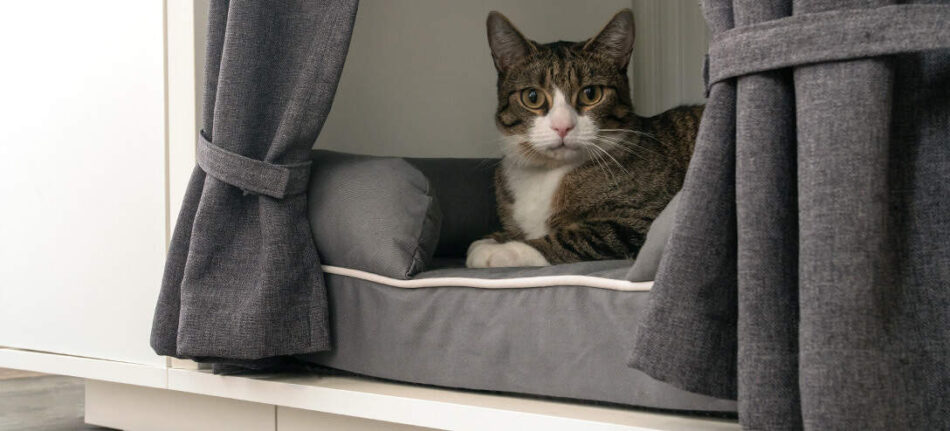
6. Whiskers help protect cats’ eyes
Just like our eyelashes, a cat’s whiskers also have the purpose of helping protect their eyes from dust and debris.
7. Cats have whiskers on the back of their legs
Whiskers aren’t just found on a cat’s face! Cats also have whiskers on the back of their front legs. These are known as carpal whiskers. Although they may appear to look like fur, carpal whiskers help with spatial awareness and hunting.
8. Sometimes mother cats chew off their kitten’s whiskers
If you’ve ever had kittens, you might have noticed a kitten’s whiskers being chewed off by their mother or even their littermates. Most commonly, cats do this either out of habit, as a sign of stress, boredom, or excessive grooming. To prevent unwanted behaviours, cats should be provided with a range of boredom busting cat toys to keep them both mentally and physically stimulated.
9. Cats shed their whiskers
You’ll no doubt have found your cat’s fur lying around the home, but what about their whiskers? Cats usually shed between 1 and 3 whiskers a year, which is nothing to be concerned about. However, if you notice excessive whisker shedding, this could indicate what’s likely a skin or stress issue, so should be looked at by your vet.
10. Your cat’s whiskers can change colour!
As your kitty ages, you’ll probably notice their whiskers changing, or losing, colour along with the rest of their coat. Depending on their breed, their whiskers will usually turn grey or black.
If you enjoyed finding out 10 things you might not know about cat whiskers, find out some more fascinating facts on cat’s whiskers and their senses in our previous blog The Seven Fascinating Senses of Cats.
This entry was posted in Cats
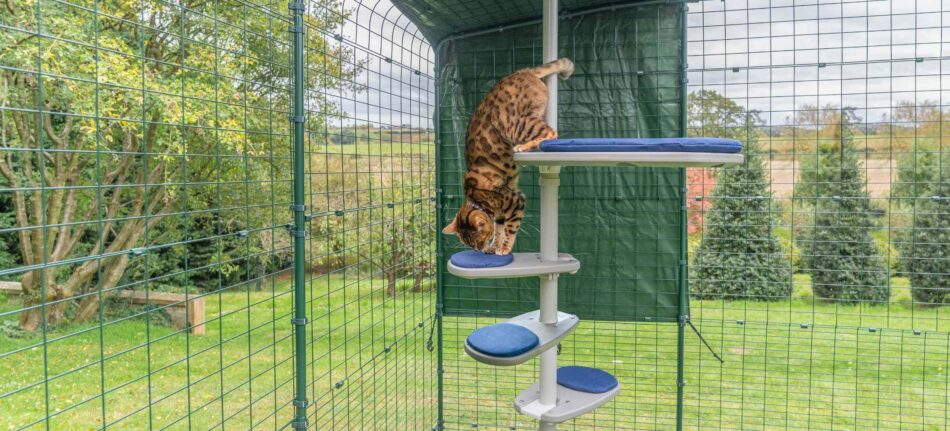
When it comes to wildlife in the garden, is your cat as ruthless as a raging lion or timid as a mouse? We might want to believe that our feline friend wouldn’t hurt a fly, but as descendants of their larger feline members of the family, cats are natural predators, whether we like it or not. But do all cats need or want to kill, and can you stop them from hunting? Sadly, the answer is no, despite spoiling them rotten or pampering their every need. Given the opportunity to go out and hunt, most cats will take it, purely because they have the animalistic instinct. So how can you make your cat’s interaction with wildlife in the garden safer?
Hunter or hunted?
Even the most cuddly and affectionate cats can resort to their hunting instincts, but they’re not always the predator…
Allowing your cat to roam freely in the great outdoors isn’t always the safest and because they’re solitary creatures, they will hunt alone. This makes them more vulnerable to attacks from larger predators such as dogs, foxes, mink, and raccoons, as well as getting into fights with other cats and more human threats like cars, poisoning or thieves.
As a predator, our cats can impose a huge threat to our wildlife and nature’s neighbours. Your kitty is capable of killing wild animals such as birds, reptiles, and small mammals and while they don’t always bring the kill home, there is every chance they’ve already been consumed.
Hunting and hunger
Hunting is not solely motivated by hunger but the way you feed your cat will certainly make a difference to how they hunt. Cats are opportunistic hunters and know that if they were to hunt only when hungry, they could risk starvation, purely because capturing prey isn’t always successful and isn’t always available. Today, cats have evolved to change their daily patterns depending on the food that is available to them.
Ultimately, whether they’re hungry or not, hunting is an instinctual behaviour. The average well-fed pet cat partakes in approximately 3 hours of hunting each day, whereas a cat that is fed less will hunt more, so it’s important to feed your cat at regular intervals throughout the day to mimic their natural feeding patterns. They’ll also benefit from a meal rich in meat content.
Cat safety
To avoid the hunting impact that your cat has on the local wildlife and protect them from predators and human dangers, we designed the Omlet Catio. Finally, cats can play safely in the fresh air! The Omlet Catio can be extended and adapted at any time to suit your cat and space and if you don’t have a large garden, no problem. Introducing the Catio Balcony Enclosure – perfect for apartment balconies. Now, cats get all the stimulation they need while both they and the wildlife in your garden stay safe.
If your cat does spend a lot of time outdoors and you’re concerned about wildlife and your cat’s hunting habits, there are a few things that can help.
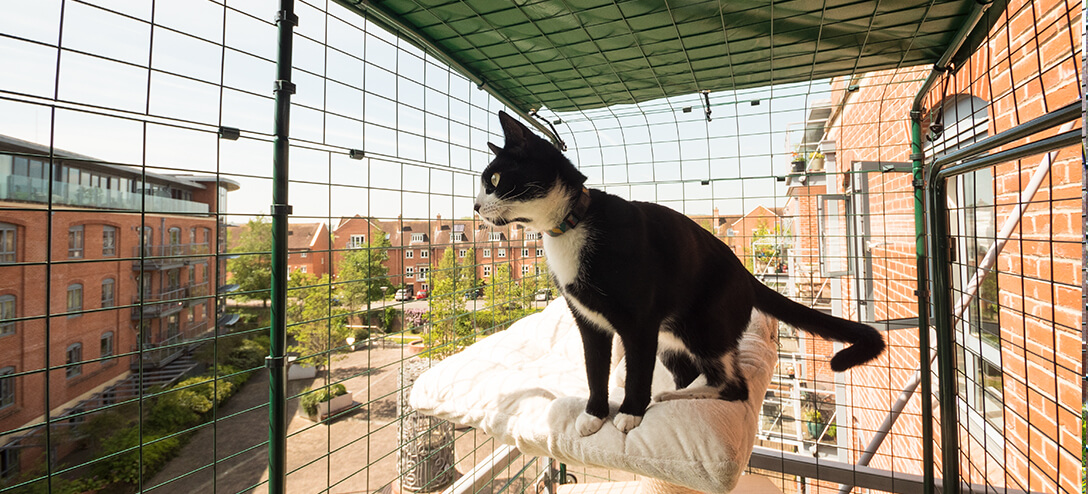
More time to play
Similar to their food patterns, the way cats play can affect how they behave in the wild. Regularly play with your cat and offer them cat toys that resemble prey. We’ve all seen the way cats crouch down ready to pounce on a scrunched-up ball of newspaper. If your cat doesn’t go out and is purely an indoor cat, don’t worry, you are not depriving them of their ancestral hunting heritage. Hunting doesn’t necessarily mean killing prey, which is why it can be adapted to play.
You can also introduce a cat scratching post for some extra brain stimulation. The Omlet Stak cat scratching post is perfect for cats plus the environment, made with durable cardboard that can withstand endless scratching sessions. Entertain your cat’s curious mind and hunter instinct rather than try and diminish it.
When not to hunt
Try to avoid dawn and dusk, prime hunting times. However, remember that changing a cat’s routine needs to be done slowly to ensure it’s not having a negative impact on the cat.
Cats need variety
Cats are neophiliac, which means they absolutely love variety – especially when it comes to food. Regularly providing different foods may curb their hunting behaviour as they don’t need to look elsewhere for new tasty treats.
Sound the alarm
Adding a bell to the collar is certainly one way to alert prey that danger is coming, however, cats are incredibly intelligent. Just be mindful that while this may seem to work to start with, your cat might find a way to master this new skill of getting close without making a noise.
Omlet and your cat’s hunting
Omlet can’t stop your cat’s hunting but with products like the super secure Catio and Stak cat scratcher to keep them entertained for hours, your feline friend’s habit can be much safer for both them and wildlife.
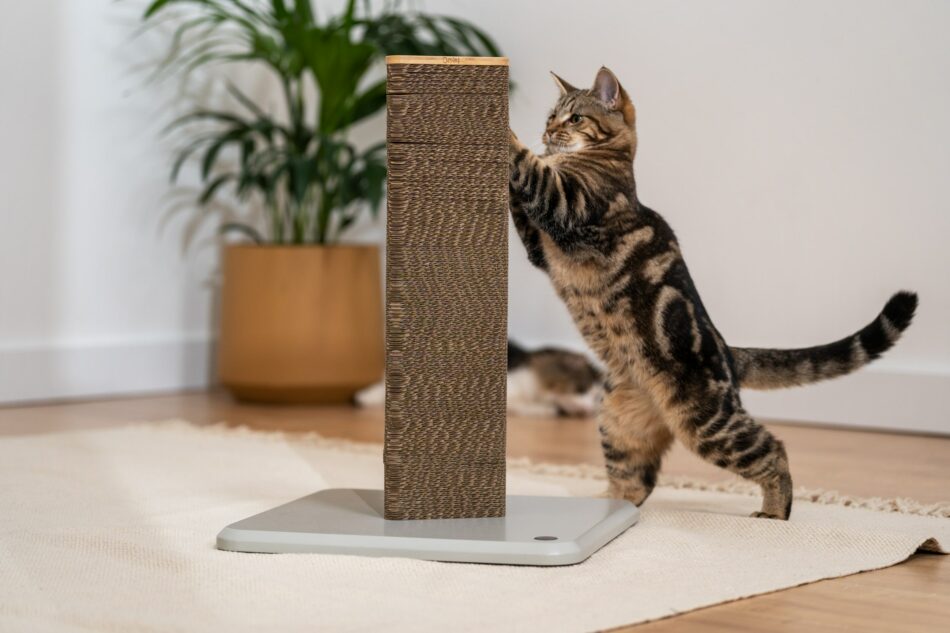

This entry was posted in Cats

Spring is the ideal time for a fresh start! Whether that means having one big clear out, starting a new project, or getting organised, it presents the perfect opportunity to have a bit of a change! So why not get your cat or dog involved with your spring overhaul so that they can start the new season in tip-top condition! So, how do you begin a spring clean of your cat or dog’s life?
Remove Pet Hair From Around the Home
Before making a start to your cat or dog’s own spring clean, grab the supplies and get to work on removing any pet hair or dirt from around the home. Many pet parents will agree that getting rid of animal hair from around the house seems to be an impossible task, especially if you’ve got a cat or dog that sheds a lot.
However, there’s no need for harsh chemicals when cleaning the house with pets. For your carpets, a top tip is to sprinkle down some baking soda before hoovering. Not only will this help to remove hair, but the baking soda will minimise odours. Just be sure to use a hoover that has been specifically designed for dog and cat hair to make things a bit easier!
When it comes to cleaning fabric sofas, you can simply use a dry sponge and this will pick up any cat or dog hair lying around. For more household cleaning tips with pets, you can read our previous blog Cleaning Tips For Dogs Who Love Mud!
Using a pet blanket on top of beds and sofas, however, is the best way to keep your furniture protected in the first place, as well as providing your pet with a cosy spot to relax.
Clean Your Pets’ Beds
Now that the household spring clean is complete, it’s time to focus on your pet, and a great place to begin is by cleaning their bed. We wouldn’t like to sleep on a dirty mattress, so neither would our pets. And with dogs sleeping between 13 and 14 hours a day, and cats between 12 and 16, it’s fundamental to provide them with a clean, secure, and safe place to rest. Fortunately all Omlet beds are conveniently easy to clean, with removable covers and toppers that are machine washable.
Alternatively, treat your cat or dog to a new bed this spring. For cats, the Maya Donut Bed comes in a wide range of colours that can add a touch of spring freshness to your home for the season. The Topology bed is perfect for dogs, with the option of raised feet, which improve home hygiene and airflow.
Give Your Cat or Dog a Groom
Spring cleaning wouldn’t be complete without a bit of a pet makeover! Well, not necessarily a full head to paw transformation, but a good bath and brush go a long way! Depending on the breed of your dog or cat, they might need to make a visit to the groomers, but it’s a good idea to keep on top of a basic regime at home. Furthermore, grooming is not only for your dog or cat’s appearance but is also important for your pet’s health by aiding with keeping their skin healthy and preventing fleas or ticks for example. Take a look at Omlet’s wide range of grooming tools for both cats and dogs to help you make a start.
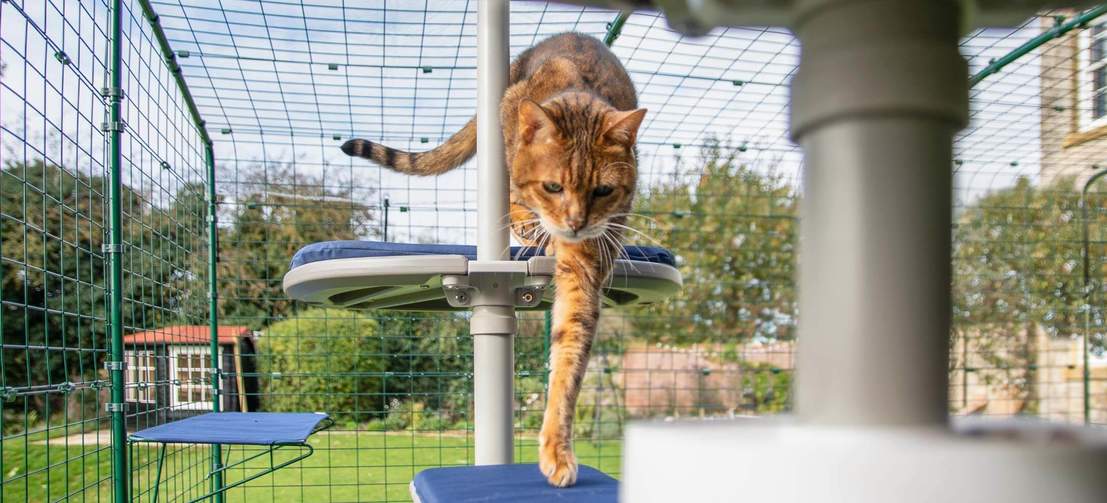
Choose from a range of accessories for your cat’s Freestyle Outdoor Cat Tree.
Treat Your Pet to Some New Toys and Outdoor Entertainment
Spring means some warmer weather is on the way, so both pet owners and our furry friends will be spending much more time outside. A few new toys will be greatly appreciated by your cat or dog, as they adjust to the new season after spending a lot of winter cosied up indoors. Or how about treating your cat to their very own catio, which is perfect for indoor and outdoor cats alike, who love adventuring but need to remain safe in the garden.
A cat tree is also bound to spruce up your cat’s life this spring! The Omlet Freestyle Cat Tree is now available in an outdoor setup. Made with weatherproof, rust-free materials, it’s ideal for unpredictable April showers!
Prepare for the Heat
Before we know it, summer will be here, so why not get prepared as early as possible by giving your pets the best chance of staying protected from the heat. Something to invest in during spring is a cooling mat for your dog. The Omlet Memory Foam Cooling Mat has a non-toxic self-cooling gel inside, meaning that the mat doesn’t require any refrigerating. You can place your pup’s mat either on a flat surface or on their bed and they’ll stay nice and cool for up to three hours – the perfect summer accessory!

Spring is just around the corner, so there’s nothing stopping you from beginning your tidy up from today! Before you start cleaning your home, however, it goes without saying that any cleaning products you use in your house should be pet-safe, so always make sure to check the labels. How will you be spring cleaning your cat or dog’s life?
This entry was posted in Cats
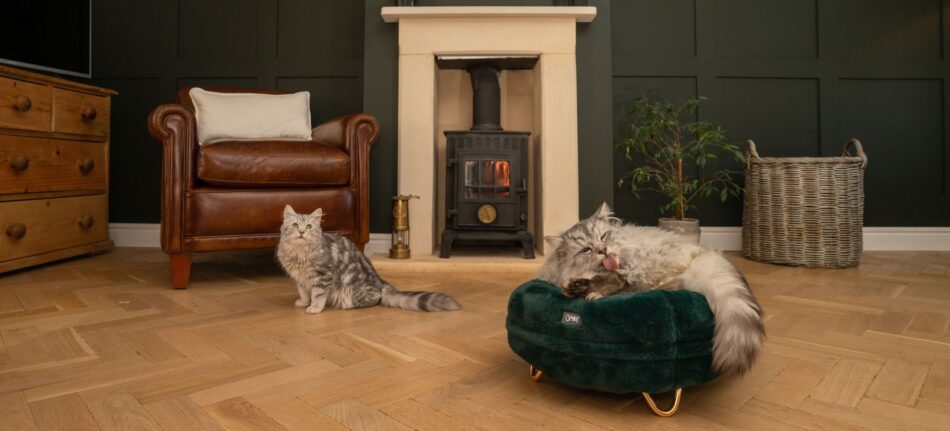
Just like us, our cats feel the effects of the cold weather that comes with winter, with some breeds less equipped for the harsh weather than others. Hairless cats, or cats with shorter coats, for example, struggle to retain their body heat during the colder winter months. Unsurprisingly, longhaired breeds such as Siberians find it easier to adapt to the cold because of their long and thick coats that offer layers of protection. However, sometimes all of our feline friends need that extra bit of help to prevent them from becoming too cold when the temperature drops. Here’s how to keep your cat warm in winter.
Do cats get cold in the house?
If you have indoor cats, you may be wondering whether they can be affected by the cold weather as well. The answer is, yes! Whilst we can try our best to keep our homes warm by turning up the heating and wearing more layers, certain rooms always seem to feel as though they have more of a draft than others.
How can you keep your cats warm in a cold house?
Our homes can get pretty chilly over the colder months, which means you’ll often find your cat moving to areas where they can find the most warmth. Luckily, there are several ways that you can help keep your outdoor, or indoor cat warm in the home.
Do blankets keep cats warm?
One way to keep your feline friend warm inside of a colder house is to purchase a cat blanket, which you can place over a piece of furniture that your cat likes to spend time on, or even on top of their own bed. The Omlet Luxury Super Soft Cat Blanket is ideal for cold weather, with a quilted grey plush on one side, and a luxury sherpa on the reverse. How about using your pet’s blanket along with a cardboard box and cushioning to build them a cosy den? Find out how you can make one here.
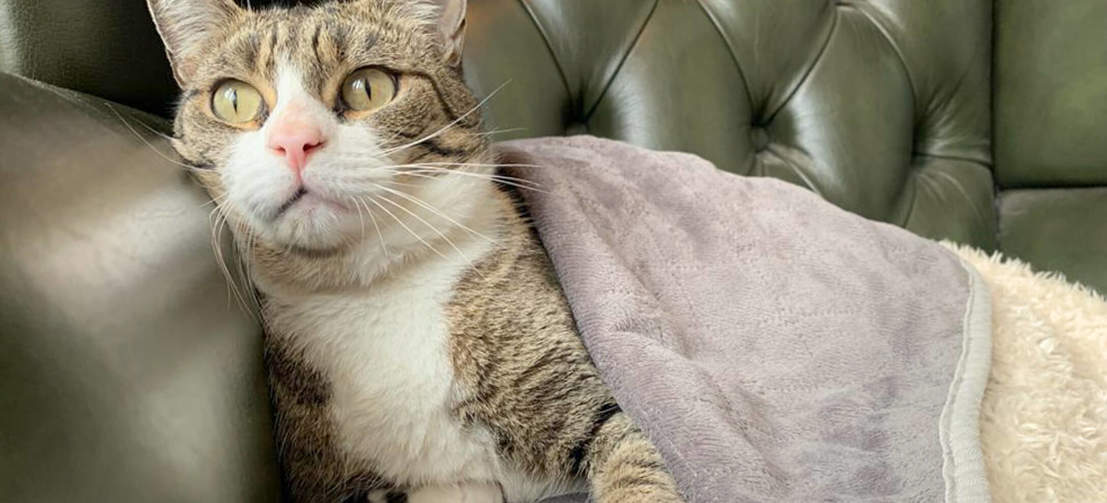
A cosy bed
In a previous blog, we explained why some cats prefer to sleep on our beds instead of their own. However, having a good quality, cosy pet bed could help to resolve this issue as well as keep your cat warm in a cold house. The Bolster Cat Beds and Maya Donut Cat Beds are great options, both having been designed to provide your cat with ultimate levels of comfort in mind. The snug Maya Donut Bed is perfect for winter weather, with the deluxe faux fur being irresistibly soft and cosy, alongside its squishy cushioning, making for a bed that your cat won’t want to leave!
A safe and warm hideaway
For additional comfort for cats during the winter weather, you can place your cat’s bed inside an indoor cat house. A cat house can be placed in any area of your home and will protect your cat from drafts and disturbances in their private den. Whilst many cats love having their own cat house, some initially struggle with using it, so take a look at our previous blog How to Get a Cat to Use a Cat House for a bit of advice.
An additional top tip to help keep your cat happy and healthy over this period is to feed them more. You might notice that when it’s colder your cat appears to be more hungry, just like us! This is a response to burning more calories as they maintain their body temperature to stay warm. Try adding a bit more to their food to their diet or provide them with a few more nutritious treats to keep them going.
Something else to be aware of during the colder months as a cat owner is the location of their litter tray. Of course, it’s only natural to want to keep cat litter odours at bay, which can mean placing their indoor litter tray in a room away from where the family spends a lot of time. However, secluded areas of the home such as the garage can have more of a breeze, so be sure to move it to a warm room if need be.
What temperature is too cold for cats?
Extreme weather conditions such as really low temperatures can be detrimental, and even fatal, to cats. Older cats and kittens, as well as indoor cats, in particular, are more susceptible to feeling the cold as their bodies are not as well adapted as cats who have spent more time outdoors. Other factors such as body weight and fur also play a role when it comes to dictating what temperature is too cold. The general rule of thumb, however, is that they should not be left outside once it reaches below 7ºC.
When cats are left outside in freezing temperatures, they become at risk of developing frostbite and hypothermia. If your cat has been outside and displays symptoms such as excessive shaking, shallow breathing, being cold to touch, having blistering on their skin, or icy paws, tail tip or ears, when they return, you must contact your vet immediately.
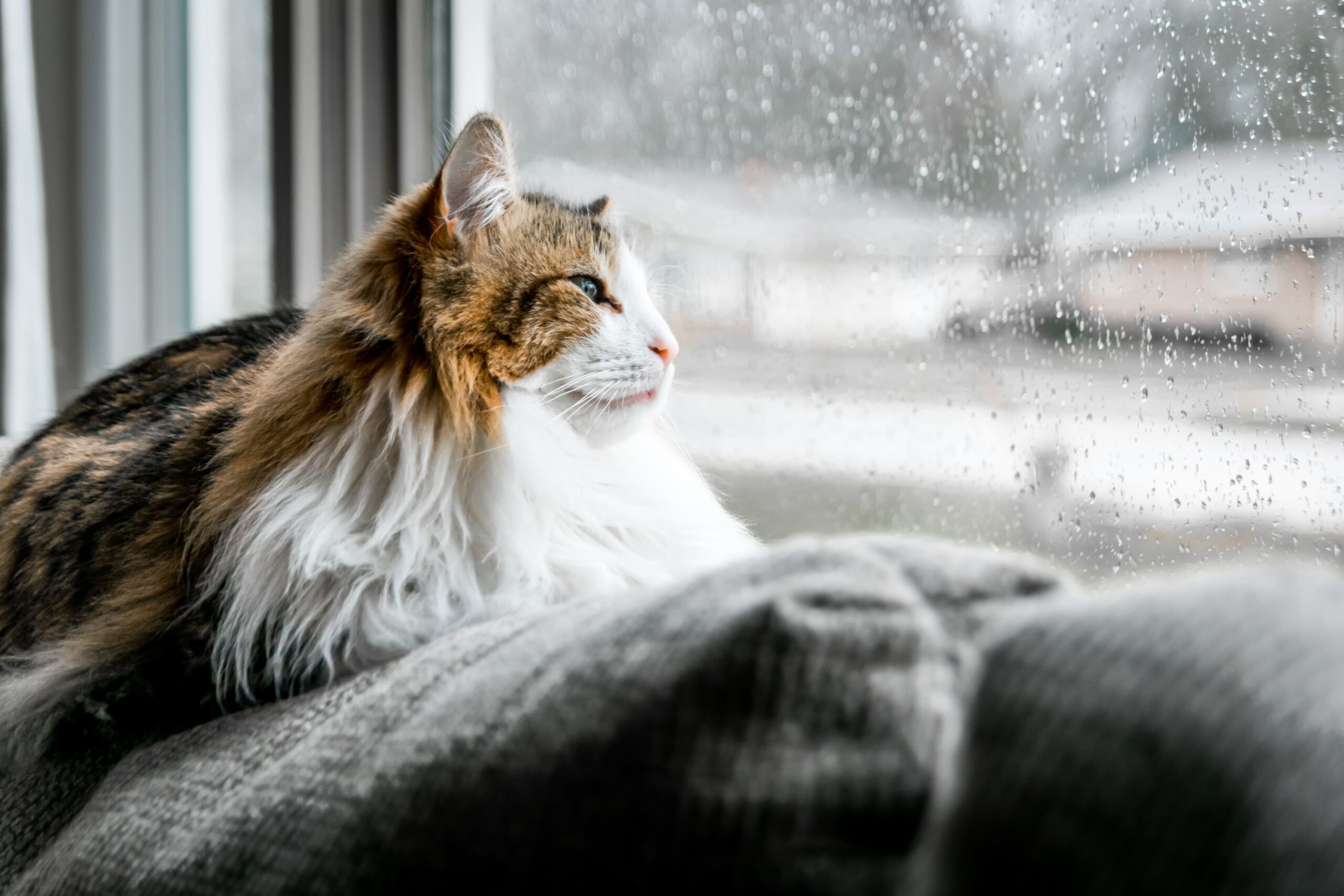
Is it okay to let your cat outside in winter?
The best place for cats to be over winter is indoors, where you know you can keep them safe. We earlier found out just how dangerous the low temperatures can be for cats, so it’s wise to keep them indoors until it warms up again. Fortunately, when the weather gets too cold, most outdoor cats will naturally retreat to their home, where they know they’ll be warm. However, it might take other outdoor cats a bit more convincing. Keeping your pets entertained with plenty of stimulating cat toys is a good idea to help them get through this period, which will help with meeting their physical and mental exercise needs.
Does cats’ fur keep them warm in winter?
Cats’ fur plays a vital role in protecting their internal body structure, and how they communicate. Have you ever noticed how your cat’s hair stands on end when they’re agitated? Your cat’s fur is also there to keep them protected from the outside elements like the cold, but also from warm weather. The amount of sunlight affects how much your cat sheds, which is why you’ll find that they will often shed more during the summer months. During autumn, when we begin to lose sunlight, cats will grow a thicker winter undercoat to keep themselves insulated, ready for the cold weather.
As we previously touched on, this means that cats with longer hair have more protection from the cold weather. Hairless, or cats with short coats, need a bit more help staying warm over this season. It’s important that you are able to provide your cat with a safe, warm indoor space, regardless of breed, along with investing in additional winter supplies such as blankets. For hairless cats who struggle more this time of year, you may wish to purchase a jumper for them to keep snug. Just be sure that they are completely comfortable and the fabric doesn’t irritate their skin.
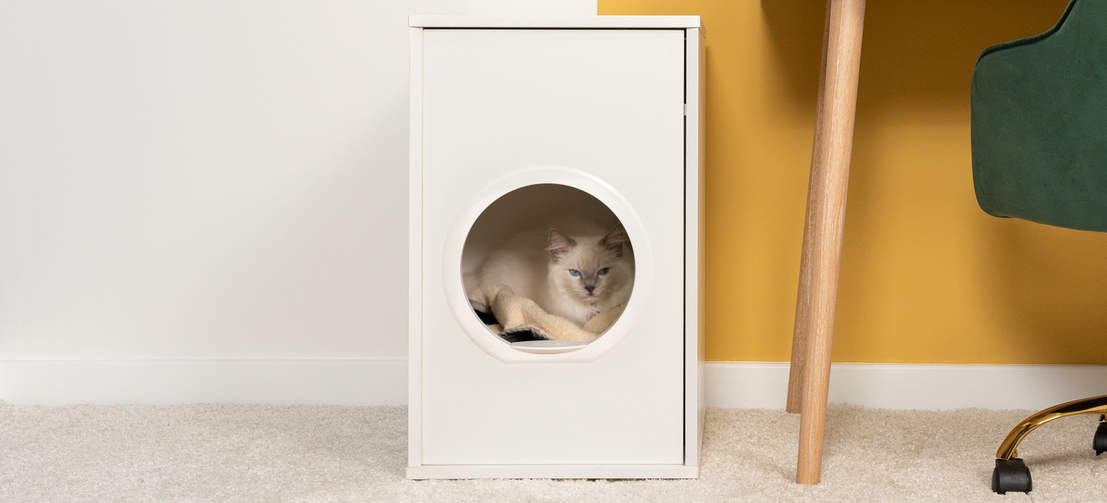
The winter can be a tough time for our pets but as we get through the last few months of cold weather, you should continue to make sure that you’re helping to keep your cats happy, healthy, and warm with the right resources!
This entry was posted in Cats
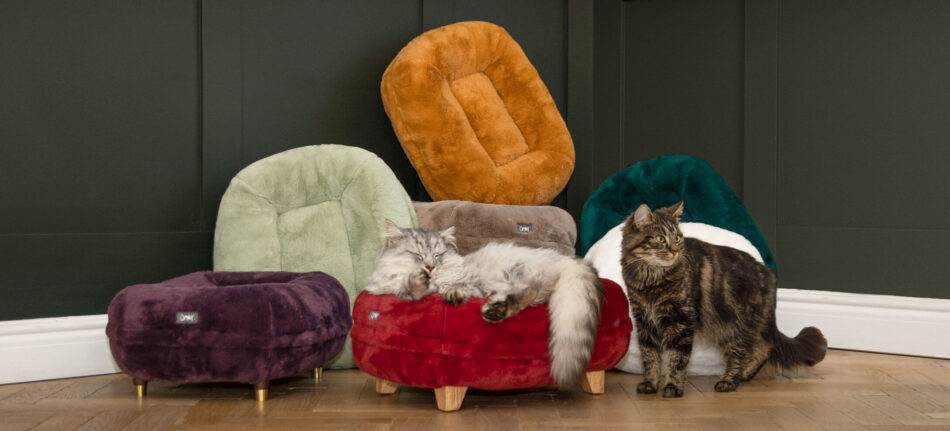 With the new Cosy Collection, there are six new amazing Maya Donut Cat Bed colours to choose from! If you like them all, or are just a bit indecisive, why not let your cat’s personality decide? Take the test to see which colour bed your cat should have!
With the new Cosy Collection, there are six new amazing Maya Donut Cat Bed colours to choose from! If you like them all, or are just a bit indecisive, why not let your cat’s personality decide? Take the test to see which colour bed your cat should have!
What time does your cat wake up in the morning?
- They do all their sleeping in the daytime
- 5am
- 7am
- Whenever I wake up
- When they hear the noise of food bowls being filled
- Never before noon
What does your cat do when allowed outside?
- Just sit by the door waiting to be let in again
- Chase squirrels and birds
- Sleep on a garden chair
- Go meet up with their mates
- Sit in a tree and groom themselves
- God knows, they just run off
You have to take your cat to the vet, how do they react?
- They love it
- Run and hide somewhere I can’t get to them
- Hiss and scratch
- They make an awful fuss for a while, then happily jumps in the carrier
- They always behave really well
- We have to get the vet to come to us, it’s the only way
What word would you use to describe your cat?
- Quirky
- Playful
- Needy
- Lazy
- Hungry
- A little bit mean
How does your cat react when you come back after a day at work?
- Just roll over and continue sleeping
- Run towards me
- They always sit by the door waiting
- They are nowhere to be found
- Make sure I notice them, then go and sit by the empty food bowl
- Come in to say hi, but go away again pretty quickly
What animal would you cat be friends with?
- They are a bit of a loner to be fair
- Other cats
- Smaller animals
- Larger animals
- Dogs
- They could get on with anyone
What is your cat’s favourite treat?
- Anything with catnip
- They just love normal cat food
- Anything really smelly
- Expensive, organic cat treats
- It’s a bit weird, but my cat loves fruit
- My cat doesn’t care about food
If your cat went to school, what would their favourite subject be?
- History
- English
- PE
- Modern languages
- Science
- Break time
What is your cat’s least favourite thing?
- Dogs
- Getting wet
- Being alone
- Loud noises
- Being woken up
- Having their nails clipped
Mostly 1’s
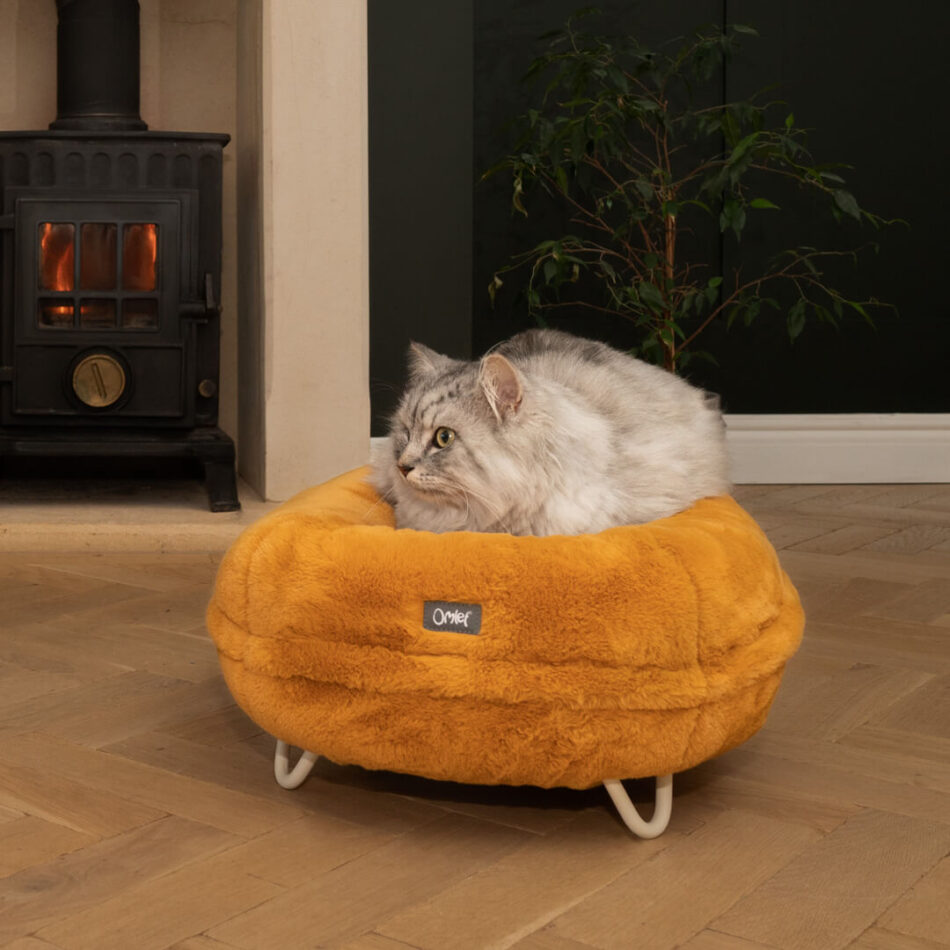
Butterscotch Yellow
Your cat knows what it wants, and is not afraid to say it. The Butterscotch Yellow donut bed will be a great match, and we think it will look great against their coat as well.
Mostly 2’s
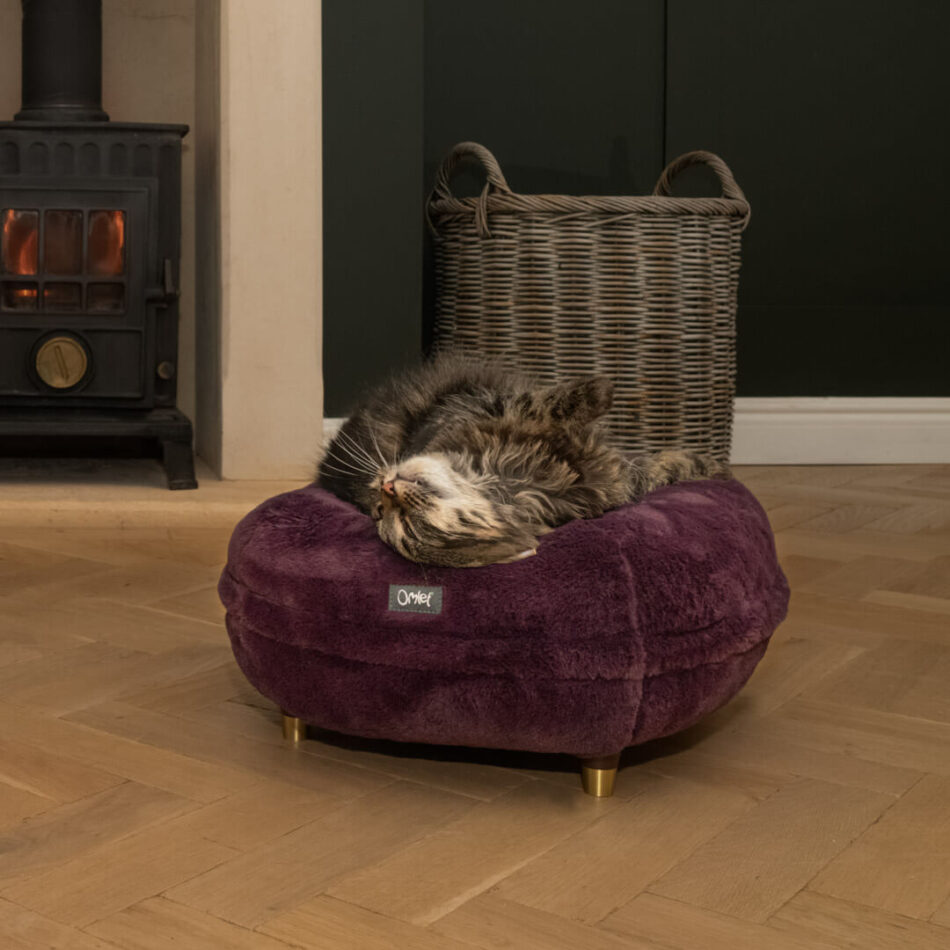
Fig Purple
Your cat is clearly full of energy, so giving them a nice, calming Fig Purple cat bed to relax on will be an improvement to their lives.
Mostly 3’s
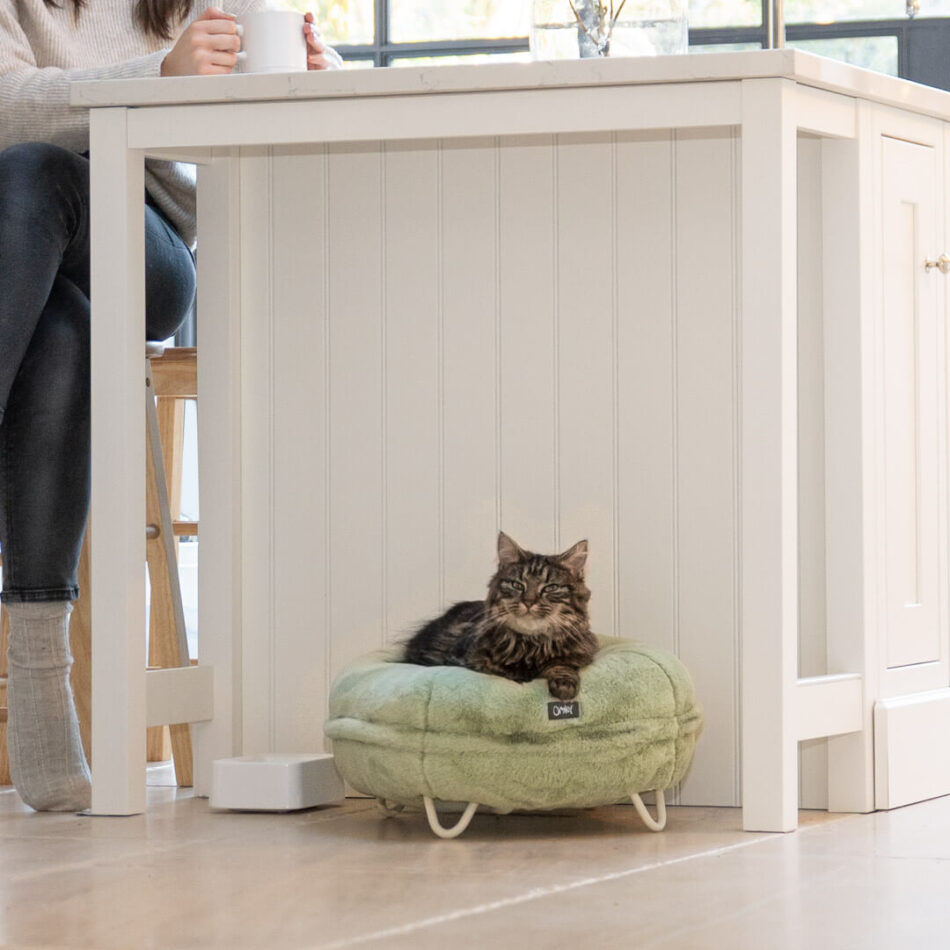
Mint Green
If your cat was a human, we’re pretty sure it would be pretty cool. Mint Green will match their amiable personality, and will look great in any room of the house.
Mostly 4’s
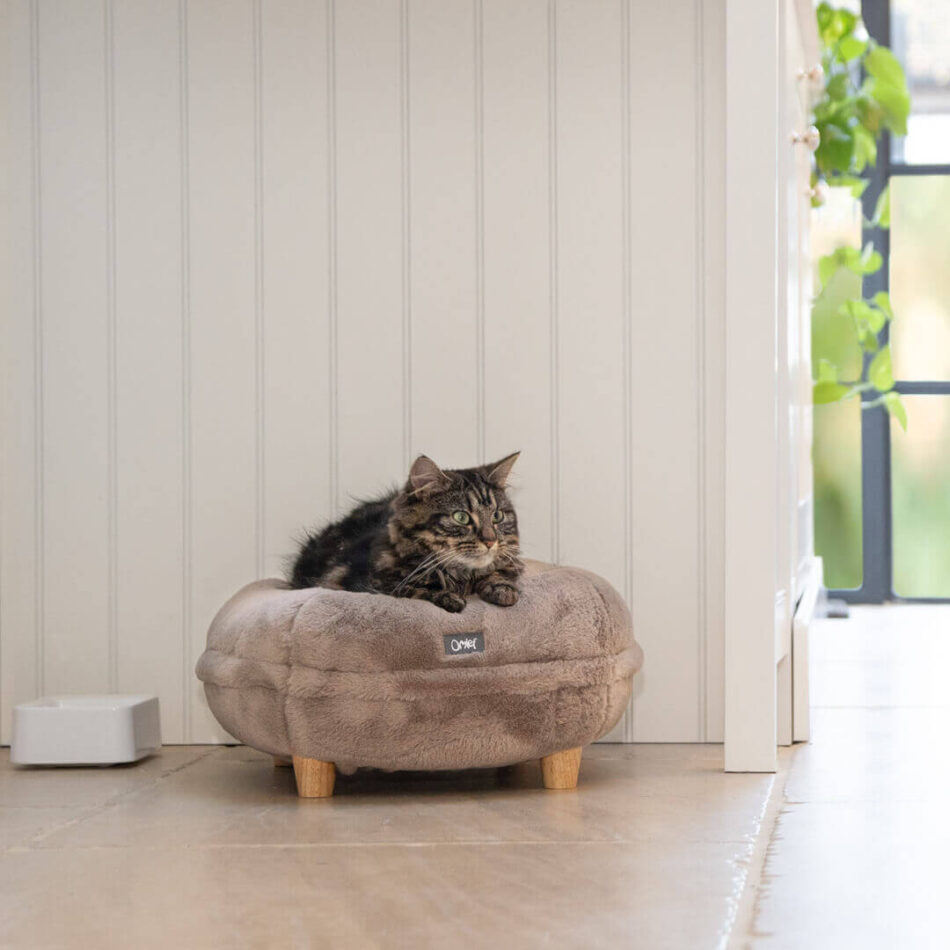
Mouse Brown
Your cat is pretty relaxed, and likes to just chill out with the family. A bed that is stylish and classic will be ideal, choose the Mouse Brown Maya Donut!
Mostly 5’s
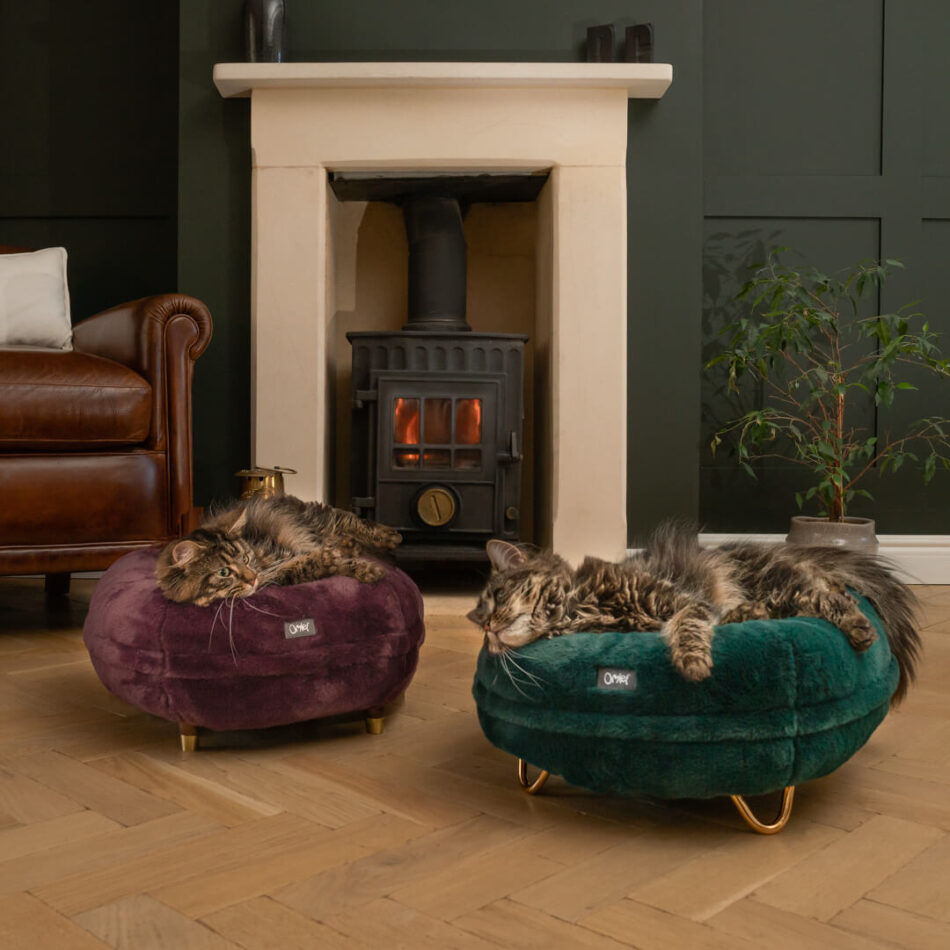
Peacock Green
We get the feeling your cat is a bit of a sensitive soul, and the colour that goes best with that is of course a lovely Peacock Green.
Mostly 6’s
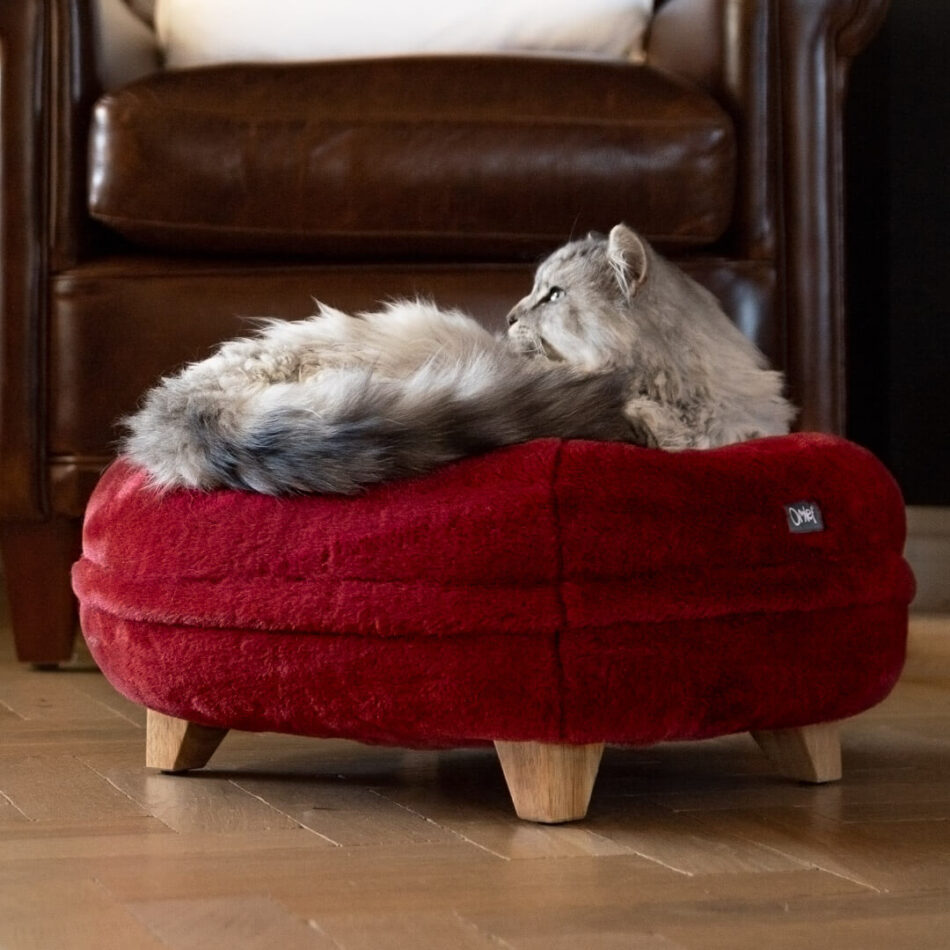
Ruby Red
Your cat is a rebel, so they need a bed to match their fiery personality! Ruby red will be perfect.
This entry was posted in Cats
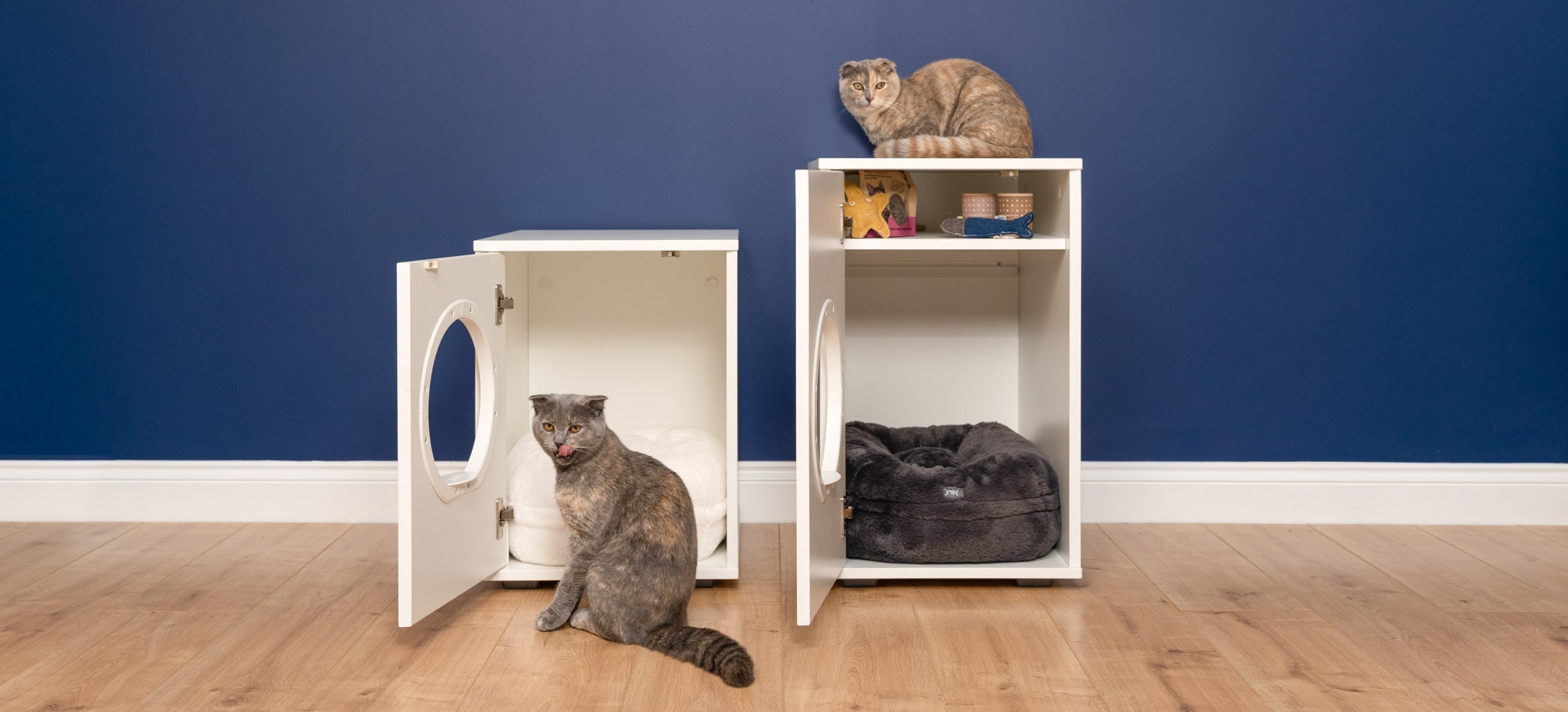 Whilst cats can be great companions, most love having their alone time too. This is because cats are solitary predators, meaning that they hunt alone as opposed to in packs like our canine furry friends do. Cats will also establish their own territory via spraying, ‘claiming’ an environment as their own, which is somewhere they should be left undisturbed. This is why it’s a good idea to invest in an indoor cat house – a safe and quiet space for your cat to relax in privacy, away from the chaos of the rest of the household! But how do you get a cat to use a cat house?
Whilst cats can be great companions, most love having their alone time too. This is because cats are solitary predators, meaning that they hunt alone as opposed to in packs like our canine furry friends do. Cats will also establish their own territory via spraying, ‘claiming’ an environment as their own, which is somewhere they should be left undisturbed. This is why it’s a good idea to invest in an indoor cat house – a safe and quiet space for your cat to relax in privacy, away from the chaos of the rest of the household! But how do you get a cat to use a cat house?
Firstly though, if you’re unfamiliar with what a cat house is exactly, they’re a shelter specifically designed for cats to be able to retreat to. Whilst some cat houses are designed to stay outside in the garden, should you have an outdoor cat, they’re not an alternative to your cat living inside of the family home. Think of it more like a home within a home for your pet.
A frequently asked question is whether cats actually like indoor cat houses. The answer to this is yes! If your cat has never used a cat house before, it could take them some time to get fully used to the idea, and they may not immediately take to their new cat house. However, rest assured, there are steps you can take to get your cat comfortable within their new shelter and once they’ve settled in, they’ll love getting cosy in their own little den!
How Will My Cat Benefit from a Cat House?
Indoor cat houses are beneficial to cats for a number of reasons, as we’ll find out. Furthermore, the Omlet Maya Indoor Cat House is great for humans too! The stylish and easy-to-clean design will fit into your home perfectly, doubling as a storage facility, making for an ideal solution all round.
Privacy
If you live in a fast-paced household, your cat might not always appreciate being the centre of attention! A cat shelter will be beneficial to your cat in that it allows them to have privacy in their own shelter, moving them away from the hustle and bustle of the home.
Safety
Another benefit of a cat house is that they provide your pet with an enclosed environment, which gives them an element of safety. If you’re a cat owner, you may be familiar with cat hiding behaviour, which cats do because a secure space can make them feel safe. It’s not usually anything to be concerned about, unless it becomes excessive, which could then be a sign of an underlying issue. If you notice your cat also avoiding eye contact, running away, or tucking their tail under them, they may be suffering with anxiety. In this circumstance, it’s always a wise idea to get advice from your vet, however, a cat house offers anxious cats their own hideaway within the family home, that will give them assurance that they have their own ‘safe zone’.
Comfort and Cosiness
A cat house will also provide your cat with a comfortable, cosy, and warm space, which is especially important during the colder months. You can place your cat’s bed inside of their indoor cat house, so they can enjoy sleeping and relaxing in their snug shelter.
How do I Get My Cat to Use a Cat House?
Just as you’d make your bedroom your own with cosy furnishings and decorations, it’s important that you make your cat’s house into a home too! By creating an environment your cats love, it will make it a lot easier for them to get into the swing of getting into their cat house.
Treats
It’s important that your furry friend associates their house with being a positive environment. One way to do this is by using cat treats to lure them in. Simply place some of your cat’s favourite treats in and around their cat house and watch as they are unable to resist going in. This form of positive reinforcement will make for a much simpler transition. Once your kitty has realised that the shelter is somewhere they actually enjoy going to, you should no longer need treats to guide them in, and they should willingly walk in by themselves.
Catnip
Why not try some catnip? – a firm favourite amongst a lot of cats, due to effects of the chemical compound nepetalactone, found in the leaves of catnip. You can read more on why cats go crazy for catnip in this previous blog here. Unless your cat is unreactive to the substance, the scent can’t be missed by cats, so it’s a perfect method for trying to get them to enter their shelter. You can use catnip either in its natural form, dried or flaked, or in catnip treats. Just as you would with regular treats, simply sprinkle your catnip in and around their cat house to tempt them in.
Toys
If your pet is a fan of catnip, Omlet also provides a number of cat toys that contain the ingredient, which can be used to entice your cat into their house. If your cat isn’t too big on the stuff, don’t worry, as you can use any other type of cat toy that they really enjoy playing with. Initiating play with your cat and any of their favourite toys outside of their cat house, again will allow them to make positive associations with their house, teaching them that great things happen when they go near the shelter!
Chase toys are particularly good for this activity, as it will mean that your cat could end up chasing the toy directly into their house. Cats have a natural instinct to chase, meaning that many go wild for these types of toys.
Additionally, once your cat has settled into their house, it can also be used as storage for their toys!
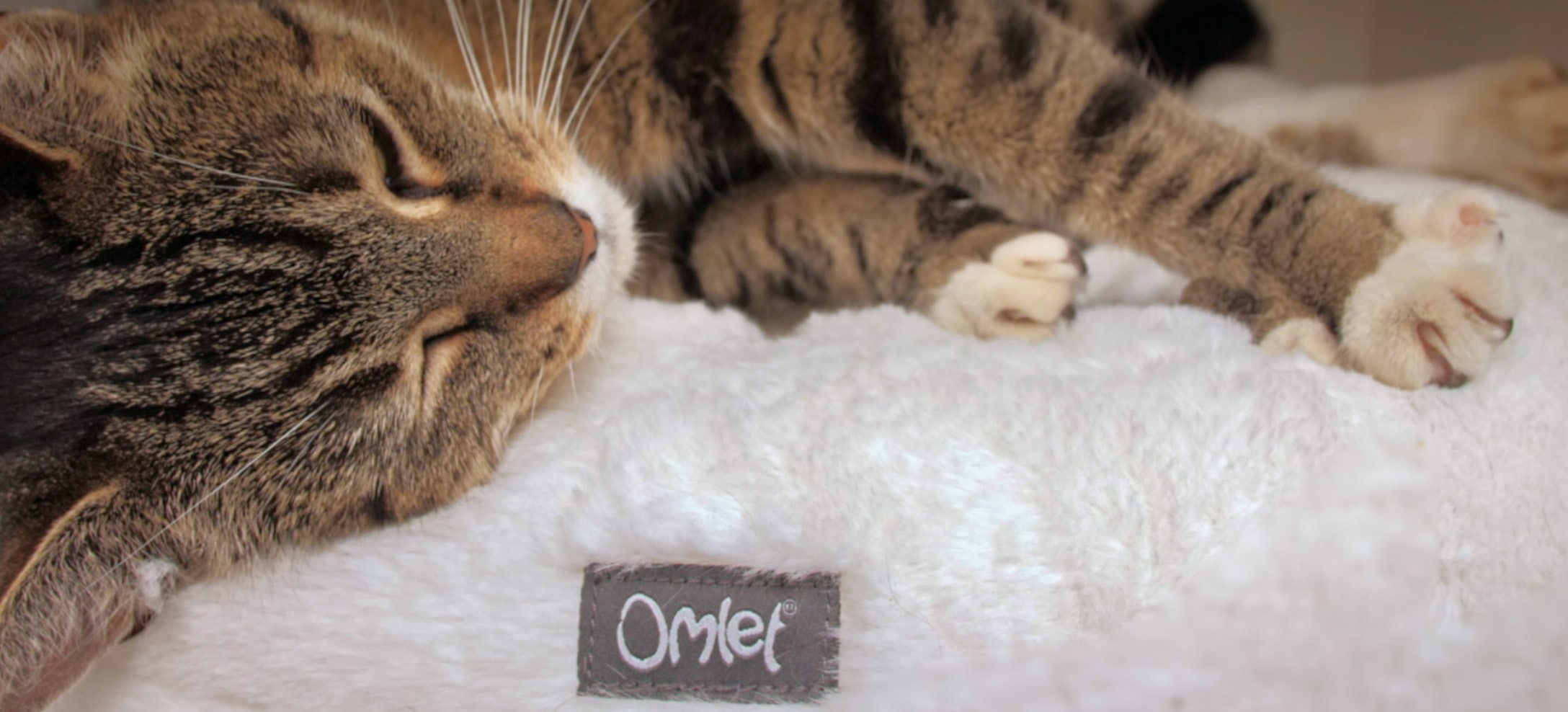
Comfy Bed
Placing a comfy bed on the floor of their house is one way to get your kitty to use their house. Since your cat could end up spending a lot of their time in their den, it’s only right that their bed provides them with an optimum level of comfort. The Maya Donut Cat Bed is a great option to go for, with a deep cushioning that will have your cats sinking into the bed of their dreams.
Warm Blankets
With winter round the corner, placing a blanket inside of your cat’s den will be warmly welcomed by your pet. You can also position a soft cat blanket on top of your cat’s bed inside of the shelter to give it more of a luxury feel and have them keep even more cosy. Just as a comfy bed can work to tempt your cat into using their house, a warm blanket will be equally irresistible.
Where Can You Put Your Cat House?
 There are a number of different areas in your home that may be appropriate to place your cat house. This depends on your living situation, and your cat’s preferences. Do they like to be involved with family time or would they prefer to have their shelter in their own quiet room? As we earlier mentioned though, if you have outdoor cats, it’s not recommended that you place your Maya Indoor Cat House outside, as it is designed for indoor use only.
There are a number of different areas in your home that may be appropriate to place your cat house. This depends on your living situation, and your cat’s preferences. Do they like to be involved with family time or would they prefer to have their shelter in their own quiet room? As we earlier mentioned though, if you have outdoor cats, it’s not recommended that you place your Maya Indoor Cat House outside, as it is designed for indoor use only.
When deciding which room to put your shelter in, you may also want to consider factors for yourself such as how easy it will be to clean and whether it will look right in your home.
In a Quiet Room
As mentioned, most cats prefer a quiet life. If this is applicable, then a quiet room would be the perfect location for your house! If you have a room in your home that is not frequently used by other members of the household and is also not close to anywhere in the home where you can hear a lot of noise from the outside e.g. traffic or noisy neighbours, then this could be the right solution for you and your cat.
The Kitchen
Maybe you have a cat who likes to be more involved with family time. If this is the case, the kitchen might be best suited to placing the indoor cat house in. Furthermore, if you keep your cat’s food and water bowls in this room, then it will mean they’ll have the convenience of this too!
The Living Room
Similarly, you can also place your indoor shelter inside of the family living room, if your cat doesn’t mind a bit more noise. With the Maya Indoor Cat House, the contemporary and stylish design means that the shelter can fit in perfectly with any existing furnishings, so you needn’t worry about it clashing with your home. Furthermore, if you have any concerns about keeping a house in your living room from a cleaning perspective, the Maya Indoor Cat House can easily be hoovered and wiped down after use.
The Bedroom (If You Don’t Want Them on Your Bed!)
To have your pet in the bedroom or to not have them in the bedroom? This is a common debate amongst many pet owners, but there’s not a one size fits all answer to this question. Whilst some cat owners rule pets out of the bedroom completely, some will happily doze off with their cat at the end of the bed every night. If you’re not particularly keen about having a cat on the bed but do enjoy having their presence in your bedroom, then you can try placing the house in a corner of your room. This way, you’ll have the benefits of sharing a room with your cat but it will save you from having to clean up any cat hairs from the bed and you’ll both have your own personal space – a win-win situation!
An indoor cat house is a fantastic idea for both cats and humans, even if your cat does initially struggle with using it. What is important is to be patient and not to give up if one method of helping encourage them to use it doesn’t quite do the trick. Hopefully with a few of our tips your cat will love using their cat house soon enough!
This entry was posted in Cats
 Are you struggling to find the purrfect Christmas present for a cat lover you know? Rest assured, you’ll be bound to find something at The Omlet Christmas Market! A number of cat toys and accessories are on offer this year so you’ll want to hurry to ensure you won’t miss out on some unmissable savings!
Are you struggling to find the purrfect Christmas present for a cat lover you know? Rest assured, you’ll be bound to find something at The Omlet Christmas Market! A number of cat toys and accessories are on offer this year so you’ll want to hurry to ensure you won’t miss out on some unmissable savings!
Freestyle Cat Tree
The Freestyle Cat Tree is the ultimate gift for cat lovers! With so many different accessories to customise the tree, there’s something to suit every cat’s personality! The platforms are ideal for cats that love climbing, whilst the hammock is a great little hideaway for any cats who might want to escape the chaos of Christmas festivities!
If you’re concerned about ceiling height, the Freestyle Cat Tree is available in 6 sizes, ranging from from 1.7m up to 4.40m, meaning that it’s suitable for any home. There’s also an option to incorporate houseplants (pet-friendly of course) with the plant pot holder, which means you can have the tree fit in with your home.

Donut Cat Bed
If you’ve got a cat who loves nothing more but to snuggle up and get cosy, the Maya Donut Cat Bed will be top of their Christmas wish list this year! The donut shape means your cats will have optimum support, that will provide them with a cuddly feeling that they’ll absolutely love. The faux fur material is so soft to touch that it will have your cats in a state of pure tranquility!
Bolster Bed
The Bolster Bed is another super soft cat bed that will also be an excellent Christmas gift for any cat parents. The zip-on, machine washable covers make them ideal for getting rid of any odours or fur balls.
With a range of 15 different beautiful colours and a range of designer feet to choose from, the Bolster is ideal for any cat parents who want a stylish bed to match the interior of their home!

Luxury Super Soft Cat Blanket
No cat will be able to say no to the Omlet Luxury Super Soft Cat Blanket! The beautiful throw can be placed on your cat’s favourite spot in the home, or even in their bed to help them get an even better sleep. The blanket is dual-sided and also comes in two designs – grey and cream and poinsettia red and cream, giving cat parents the option to find the right style for their home.
Cat Toys
For a more playful cat, the Omlet Christmas Market has a selection of cat toys to make sure they don’t miss out on any fun! Smaller toys are perfect as stocking fillers, providing mental and physical stimulation for cats.
How about the adorable Pudding Snuffle Forage Mat as a Christmas gift? The hide and seek toy will keep cats entertained as you hide their favourite treats between the fabric. You can even use catnip, which will provide your fluffy friend with hours of enjoyment!
This entry was posted in Cats
Bhim Solomon is Omlet’s junior guest writer, currently exploring fun activities to try with her two kittens Moonpie and Shadow Weaver, and introducing easy tricks you can try with your feline friends! In this article, Bhim talks you through the simple steps of making an origami butterfly for your cats.

DIY Cat Toys are fun for you to make and exciting for your cat to play with at home. Origami (the ancient Japanese art of paper folding) is an excellent way of making beautiful and quick cat toys. My cats love to chase butterflies in the garden, so I decided to make a butterfly out of origami (and I think the butterflies in the garden will be very relieved too). I noticed that my cats are much more interested in things that make a sound so I wanted my cat toy to have a jingle. Luckily from Easter I had saved a bell from a big Lindt chocolate bunny, it’s perfect for this project, maybe you have one too. Other things you’ll need are:
- A stick
- Some elastic or string
- And of course some paper.
You can go on youtube to find origami how to videos, here is the link to the one I used for a butterfly if you would like to use it. If you don’t want curved wings you just don’t cut the edge. Also if you have an A4 paper you should follow the first step.
Origami tips
- Use thin paper as it’s easy to crease
- Watch the video through once and then follow on the second time
- Use the back of your nail or ruler to fold smoothly
- Fold neatly
- Use coloured paper and then draw your own pattern / eyes / words on it
- Patterned paper also looks great.
- You don’t need to have a square piece of paper, you can use a regular piece of A4 or Letter size, keep reading to find out how to make it into the perfect square…
First of all:
Collect your A4 piece of paper or if you have an origami square paper skip this step, fold diagonally across so that the corner that you folded touches the edge. Crease down the fold with the back of your nail. Then cut the extra bit off. Now you have a square piece of paper and you can start making your butterfly.
Secondly:
Unfold that crease and fold diagonally the opposite way. Open out, then fold vertically, unfold and fold horizontally. I’m not going to write all the instructions because it’s easier to watch the video.
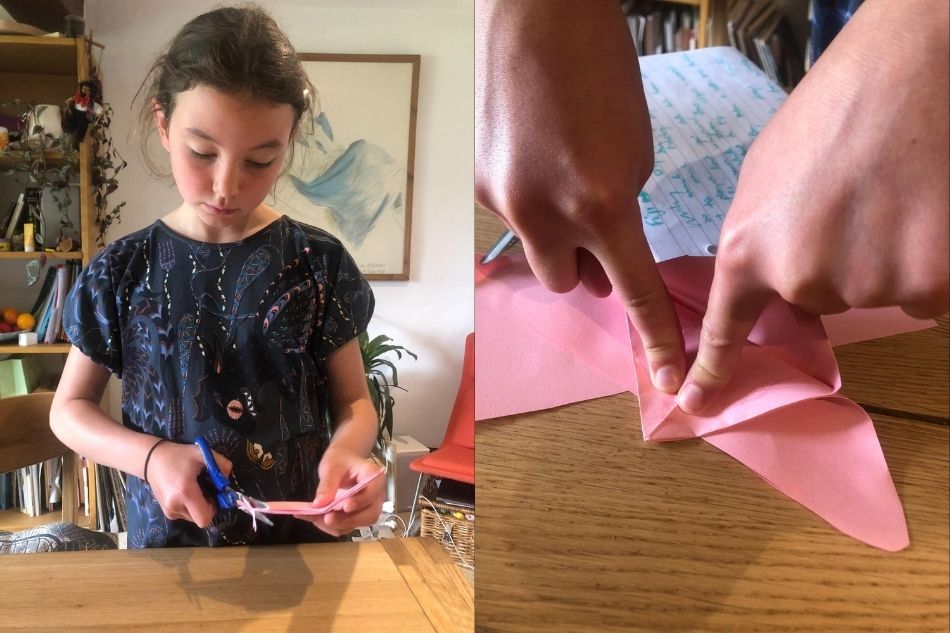
Making the wings
If we skip a bit to the cutting for the wings I wanted to have a rounded end so I cut my wings but you can leave them to get a pointed edge. After that, unfold the wings and fold the top edges to touch the middle line. Next, flip the paper over and bring the bottom corner up and fold over the top line, with about one cm above.
Turn back over and fold over. This is the head, and when the magic of origami begins! Pinch together with fingers. Hay presto paper butterfly!
Decorating your butterfly
I used felt tip pens to create a pattern on my butterfly. I did curving lines and an abstract pattern. Then I added the bell by tying it around the middle of the butterfly.
Tying your butterfly cat toy to a stick and ribbon
You can use a bamboo stick or a chopstick, a wooden spoon, maybe even a pencil as a stick. I collected a stick from the garden, try to get a fairly straight one. Gather your string or elastic and double knot it onto the stick. Now chop your string/elastic to the length you wish.
What I did was to make it easier. I asked my brother to help me. It made cutting and tying simpler.
My kittens playing with their new toy
You are now ready to play with your kitten, kittens, cat or cats! Shadow was the first of our kittens to try the new cat toy, it was a great success. I put the butterfly in front of him and he immediately got into the crouch position, the same one he uses when he’s in the garden trying to catch a real butterfly. Then I twitched the butterfly and the bell rang a bit and he tried to pounce on it but i pulled it away. Then he kept leaping and jumping around trying to catch the butterfly, it was really fun and great entertainment for him.
It wasn’t long before Moonpie crept down the stairs to see what was happening. I played with Moonpie next, I made the butterfly flutter around her and she stood on her back legs trying to paw at it. I put i on a step and she jumped to get it. I think both cats really loved the butterfly cat toy and I would definitely make another one. In fact I think I will make one for a friend who has a cat because it would make a really lovely gift.
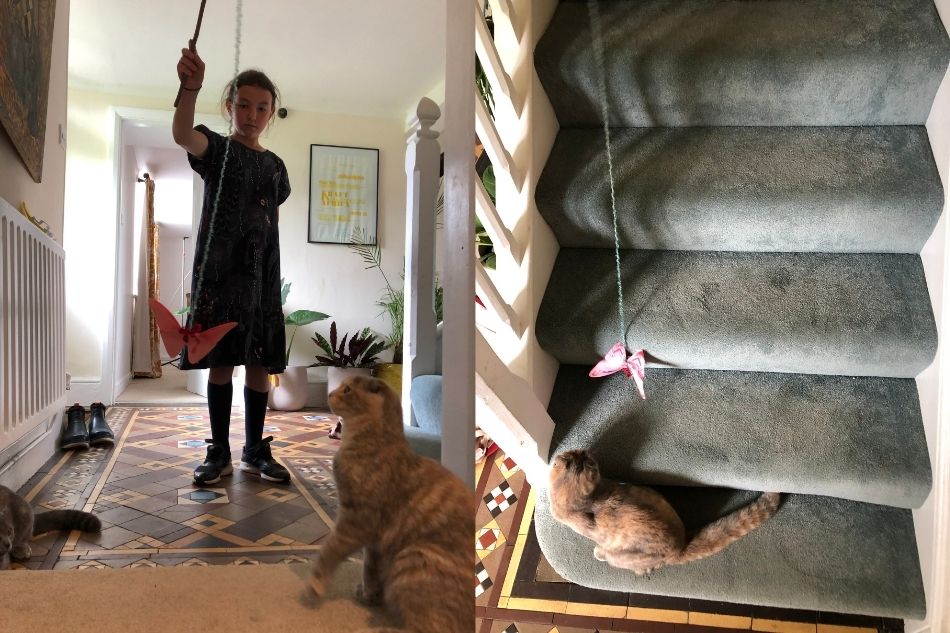
This entry was posted in Cats
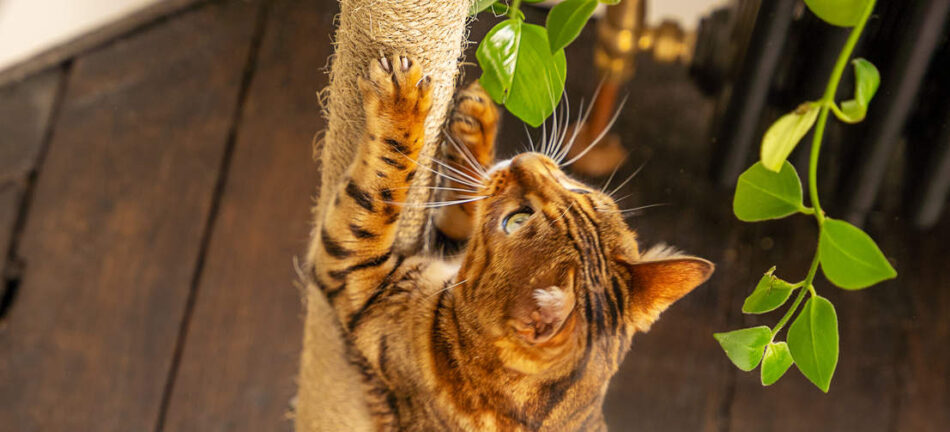
Bengal cats have striking features, bearing a resemblance to leopards with their piercing eyes and speckled, marbled coats. As their appearance suggests, this breed is a hybrid of an Asian Leopard Cat crossed with a domestic cat. So, with being part wild animal, you’ll need to think carefully before deciding to introduce the very intelligent Bengal into your home.
With the new arrival of any kitten, you’re going to have your hands full, as both you and your new furry friend adjust to a new life. It’s a good idea to get prepared by going through a checklist of everything your Bengal kitten is going to need and anything else that will make for an easier transition. If you’re struggling on where to begin, here’s a list of a few things to get you started:
A Cat Carrier
When bringing home your new Bengal, you’ll want to place them in a cat carrier, with something absorbent to line it, in case your Bengal kitten has any accidents on the journey. One piece of advice is to spray the carrier with pheromones which will help to make your kitten feel safe.
The carrier should be large enough for your Bengal to comfortably lie down in, and adjust themselves. It’s also important to remember that your kitten should not come home any earlier than 8 weeks old, as any sooner is too premature to be separated from their Mother.
A Scratching Post
Cats have a natural desire to scratch, so if they’re not provided with the right outlet to do so i.e. a scratching post, you may find that your prized furnishings are quickly destroyed! Not only will a cat scratching post help to maintain your Bengal’s claw health, they’re also a great tool to help release your cat’s hormones and excess energy.
If your house has enough space, cat trees are an even better option! The Omlet Freestyle Cat Tree will grow with your kitten, as you can customise your tree to add more accessories for your Bengal to scratch at and play with, as they become more adventurous.
A Cat Bed
Cats can spend up to sixteen hours of the day sleeping, and kittens, even longer! Cat breeds like Bengals however, will sleep slightly less due to their playful nature. Nonetheless, it’s important that you invest in a good quality cat bed, so that your kitten can get those precious hours of sleep in.
Their bed should be somewhere secluded, where your kitten can be left alone and away from any other pets or people. Comfort is key, so make sure your Bengal’s bed is cosy and somewhere they can retreat and rest.
Food, Water and Bowls
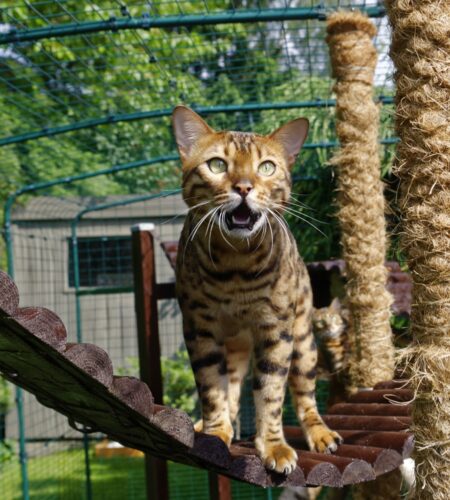
Bengals need a diet of good quality food, to give your kitten the best start. Make sure that the food you choose for your young cat is age appropriate, along with choosing appropriate sized bowls for their food and water. Cats can have a combination of dry food and wet food, and kittens need a specific diet suited to their age. From around 12 weeks, your Bengal kitten should transition to eating more dry cat food, so it’s a good idea to check with the breeder on what they recommend.
A Litter Box
Despite the incredibly active nature of Bengals, they can actually live comfortably as indoor cats, as long as they have enough physical and mental stimulation to stop them from becoming bored. Many Bengal kittens will have already been litter box trained by the breeder, however owners still need to continue to encourage correct use of the litter box by using positive reinforcement when they use it.
Also consider the type of cat litter you’re using for your Bengal cat. Take a look at the full Omlet range of cat litters to find which will be best for your kitten.
Plenty of Toys
Before bringing your new Bengal home, you should be aware that these cats need a lot of entertainment! Bengals love to play and a wide range of toys will help to keep your kitten stimulated and out of trouble. Bengals are highly energetic, so toys that encourage their hunting instinct, like the Kong Kitten Mice are perfect for your new kitten. As your Bengal grows, how about trying the Omlet wand cat toys with catnip, that will provide your cat with endless hours of fun!
Before getting a Bengal kitten it’s important to take into consideration not only these essentials but to carefully conduct thorough research on the breed and your prospective breeder. Remember, responsible breeders should also be looking at whether your lifestyle and home is suitable for their kitten to be going to. So, if you think this is the right breed for you and you do decide to get a Bengal kitten, one thing that can be guaranteed is a whole heap of fun for the whole family!
This entry was posted in Cats
? The BIG Bed Sale! ?
Save up to 25% on Bolster Beds, Topology Beds and Donut Beds for a limited time only! Now is the perfect time to treat your pawesome pal to a cosy new bed this autumn ?
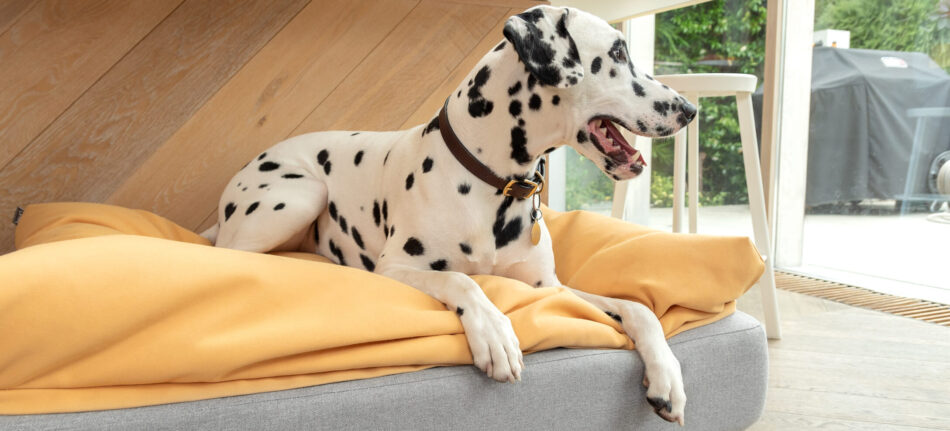
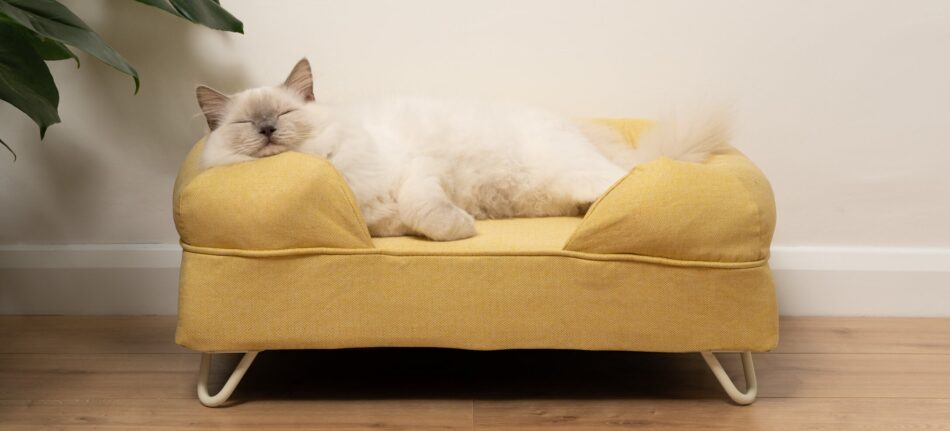
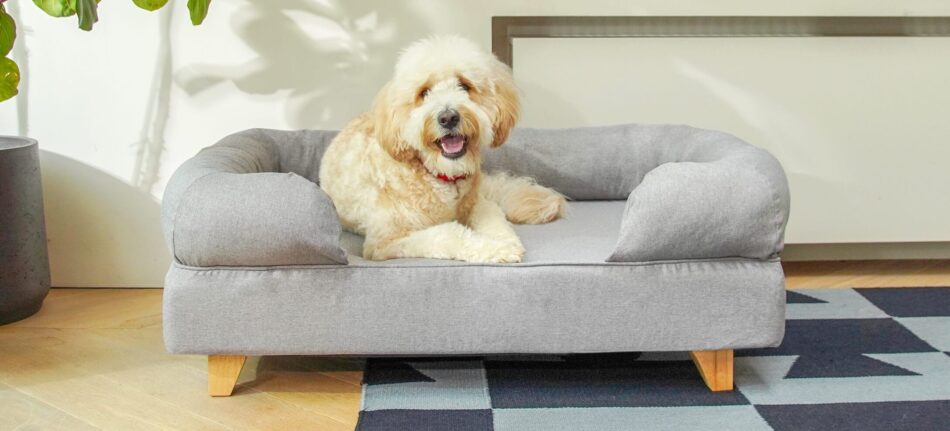

Terms and conditions
The promotion for 25% off beds is only valid from 14/09/21 to 17/09/21. The promotion only applied to Bolster Dog Beds, Topology Dog Beds, Maya Donut Cat Beds and Bolster Cat Beds, including covers, toppers and feet. Excludes all other dog and cat accessories. No promo code needed, discount has already been applied. While stocks last. Subject to availability. Omlet ltd. reserves the right to withdraw the offer at any point. Offer cannot be used on delivery, existing discounts or in conjunction with any other offer. You are not able to use a discount code on your order if your basket contains one or more discounted products.
This entry was posted in Cats

With over 70 different accessories to choose from, the Omlet Freestyle cat tree allows you to create a play area that suits your cat, their likes and abilities. You might have an idea of which accessories would best suit your cat and home, but to give you a helping hand, we’ve put together some amazing kits if you don’t want to create your setup from scratch. Plus, when you and your feline friend have discovered the ingenious design of the Freestyle cat tree, you can always extend and adapt the setup with more poles and accessories. Have a look at the 6 starter kits to find the perfect Freestyle cat tree.
The Beginner – novice necessity
The Beginner is the ideal starter kit to get your cat used to the Freestyle. It features a simple platform that can be placed at any height on your pole, accessorized with a stylish blue woven cushion to provide your cat with extreme comfort while resting off the ground.
This kit also comes with a super stable sisal scratcher kit for your pets’ grooming needs. The sisal is durable and feels nice against the paws, and is strong enough to sharpen those precious nails.
The Beginner is an economical solution, perfect if your cat is hesitant to try new things, or you have limited space in your home.
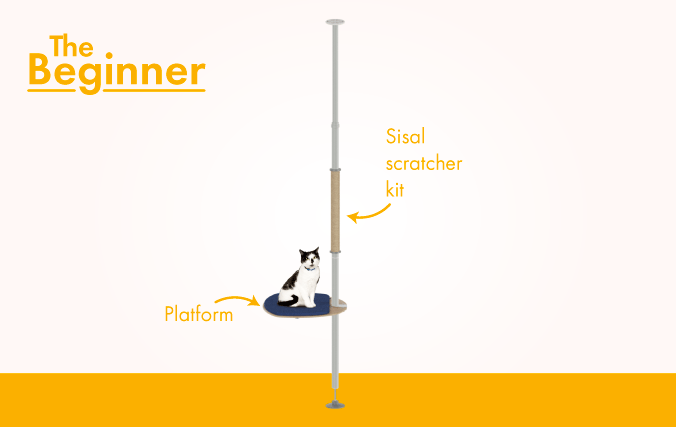
The Top Cat – curious kitties
The Top Cat is super stylish, featuring yellow cushions for the platform and steps that’ll blend in beautifully in your home. It also comes with a plant pot that can be positioned at any height on the pole and allows you to fully utilize all vertical space.
The Top Cat will suit any cat who likes to watch the world go by from a vantage point, safe from small humans and other pets. It also comes with a replaceable sisal scratcher kit, making it an ideal starter to build on from as your cat gets more adventurous.
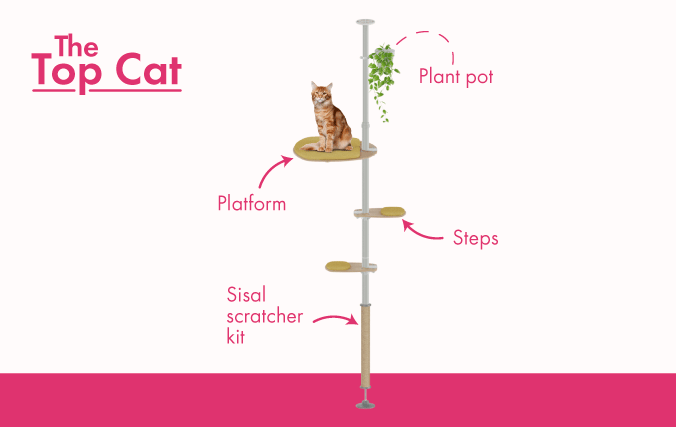
The Ladder – courageous climbers
This kit comes with four bamboo steps that you can position at the perfect height to create a ladder for your cat to climb up to safety. At the top of the pole you can put the platform with a super cosy woven den where your cat can enjoy secluded naps.
Additionally, The Ladder comes with a treat dish that can be put by the den for snack time, or at any height up the pole in case your cat gets hungry mid-climb.
The Ladder is perfect for any cat who likes to be high up and away from the noise of the household. The flexibility of the steps allows you to adjust the difficulty of the climbing based on your pet’s age and abilities.
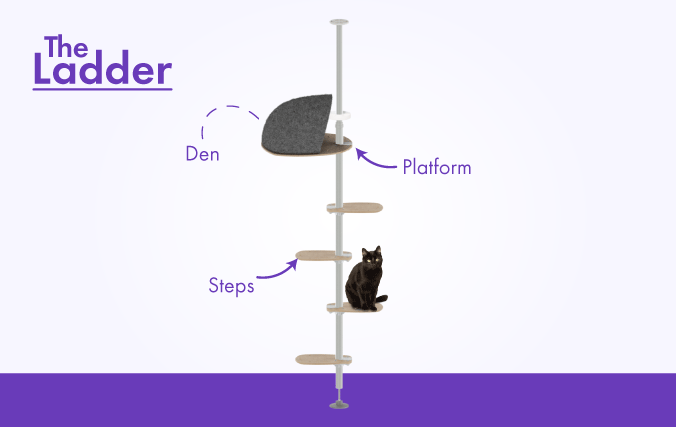
The Sleeper – cat nap connoisseurs
The Sleeper kit is perfect for super relaxed cats who will settle for nothing less than supreme comfort. The platform and steps come with beautiful woven cushions that will provide a soft surface while lounging and inspecting the home. The Sleeper also includes a secluded den that your pet can withdraw to for their extremely important naps.
This kit also includes a sisal scratching post that your cat can use for stretching out their bodies after a sleep, while also sharpening their nails.
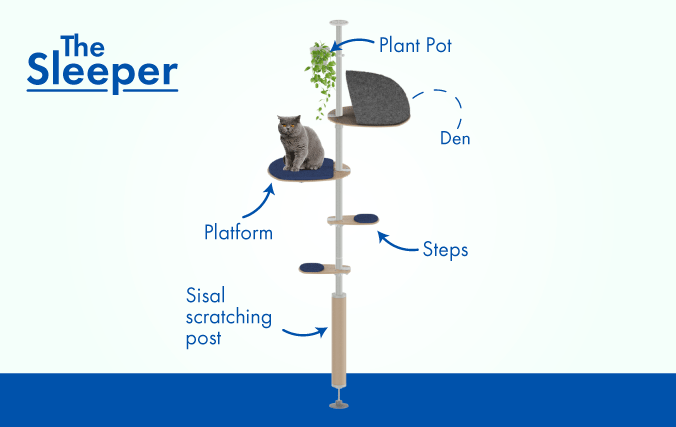
The Scratcher – kitty manicure essential
The Scratcher is the perfect solution for cats who take grooming seriously. The kit features both a sturdy sisal scratching post that wraps around the vertical pole for full-body stretching and a pole-to-floor ramp with a wave cardboard scratching box. Persistent scratchers will love this option and flexibility!
The Scratcher also comes with a cosy woven hammock for post-play naps away from the hustle and bustle.
If you have a cat that insists on sharpening their claws against furniture and upholstery in your home, The Scratcher is the ideal kit for you. By giving them a designated stable spot for grooming, they should soon learn where to go. Additionally, all scratching parts can be recycled and replaced once worn, making Freestyle a long-term solution for all.

The Explorer – fearless felines
If you have an adventurous cat that loves jumping, climbing and scratching, you should try The Explorer. This starter kit includes most of the Freestyle accessories positioned over two vertical poles, so your cat can choose an activity based on their mood on a specific day.
The Explorer has two different types of scratchers, steps to allow your cat to get up the tree, a bridge to lounge on and a secluded hammock to rest in when everything has been explored. As if that wasn’t enough, it also comes with a decorative pot for your cat-friendly plants, as well as a stainless steel bowl for food or treats.
The Explorer is perfect for young, active and agile cats, or for multi-cat households.
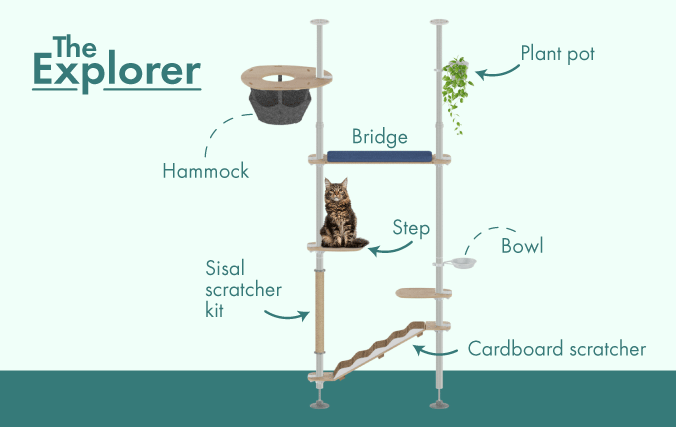
Omlet and your cat
We understand that all cats are different, which is why we’ve made it super easy for them to make their mark with our customizable kits. You can position the accessories yourself and simply move them around when you’re ready to try something new. Or, you can build your own system using our handy Freestyle cat tree configurator. Discover a new way to play with Omlet’s Freestyle cat trees. And, shop our range of other ingenious cat products such as cat beds, cat blankets, and cat scratching posts, created by pet lovers and expert engineers to help you continue building a wondrous connection between you and your pet.
This entry was posted in Cats
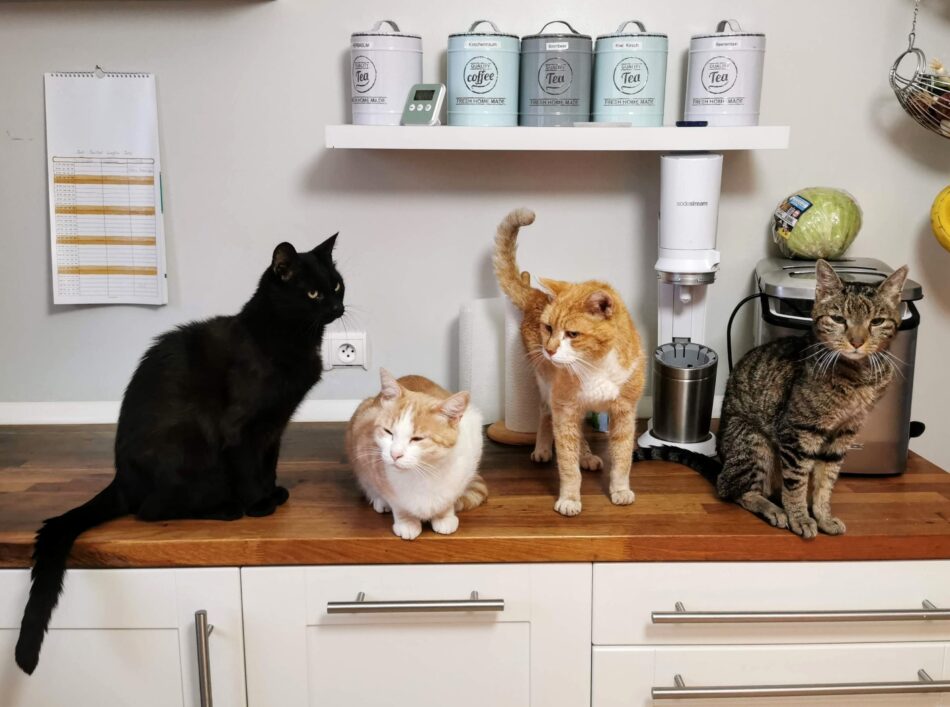
Photo by Dietmar Ludmann on Unsplash
Despite many cats enjoying being independent creatures, according to the PDSA PAW Report, 43% of cats in the UK now live in multi cat households. Whilst it’s understandable why so many of us give in to the temptation of introducing another feline friend into the home, it’s also important to be cautious of the potential onset of cat behavioural issues such as aggressive behaviour i.e. hissing, growling, or chasing as a result of doing so, and to consider if the dynamic of a multi cat household would work for you and your family. However, if you do decide to take the plunge, here are some tips on how you can try and keep the peace.
Plenty of Exercise
Providing your cats with plenty of exercise will help to keep them at a healthy weight and keep them stimulated. Both are important for all cat owners, even those who only have one cat. However, for cats who live amongst other cats, keeping active can aid with avoiding a potential build up of excess energy, which can sometimes manifest itself as aggression towards other cats in the household.
One way to help keep your cats exercised is through play, which will also help to strengthen the bond between you and your furry friend. How about trying the new Omlet catnip wand toys that will encourage your cats to chase and provide them with endless hours of fun. Another great way of exercising your pets is to invest in a cat tree. Cats love climbing and scratching, so a cat tree is one sure way to encourage this and keep them entertained.
Use Pheromone Diffusers
Pheromone diffusers are an odourless plug-in product that works by producing pheromones, or chemical substances, that your cat naturally releases when they either rub against surfaces, scratch at items, bump heads with humans or other cats, or spray. Pheromone products mimic how pheromones would naturally send messages between cats, meaning that they can help in multi cat households to have your cats to feel more relaxed, and reduce their stress levels.
Multiple Litter Boxes
It’s important that your cats have their own litter box when they live with other cats. This is because of their territorial nature, which often means that cats like to ‘claim’ where they go to the bathroom and do not like this area to be shared. If cats feel as though their territory is under threat, this can lead to aggressive behaviour such as fighting.
Furthermore, most cats will refuse to use a dirty litter box, which will likely happen should you only provide a single litter box for several cats, as of course, their waste will accumulate more quickly than if your cats were to have their own. The general rule of thumb is that you should have one litter box per cat, plus one spare to have placed out in your home.
Separate Feeding Stations
Cats like to be alone when they’re eating, meaning that if you have multiple cats, they will require separate feeding stations at mealtimes. When cats are forced to share the same area for feeding time with another cat, it can take away from their predatory instinct to hunt and eat by themselves, which inevitably can induce anxiety and aggressive behaviour. In a multiple cat home, cats may see a shared feeding area as an opportunity to compete for food, which could result in you having a ‘food bully’ on your hands. As well as providing your cats with their own food bowls, give them each a designated space in the home to eat any from any other cats.
Furthermore, creating this divide will help your cats to stay healthy by having them fed equally, or in accordance to their own specific dietary needs, as it ensures one cat cannot access the other’s food. For example, factors such as the age, weight, or medical condition of your cat/s may mean that they have to be fed different diets. Therefore, it’s fundamental that you leave each cat’s bowl out of reach from any potential cat food thieves!
Personal Space
By nature, many cats need their own personal space, even when they’re not eating. It’s a good idea to have an area in the home that they can go to escape to by themselves, away from both humans and other animals. If you have the room, it’s advisable that each of your pets have at least one of their own private areas in the home that they can go to without being disturbed and becoming overwhelmed. This may even be a cardboard box if you’re limited for space, but be sure this is away from the hustle and bustle of the home or outside.
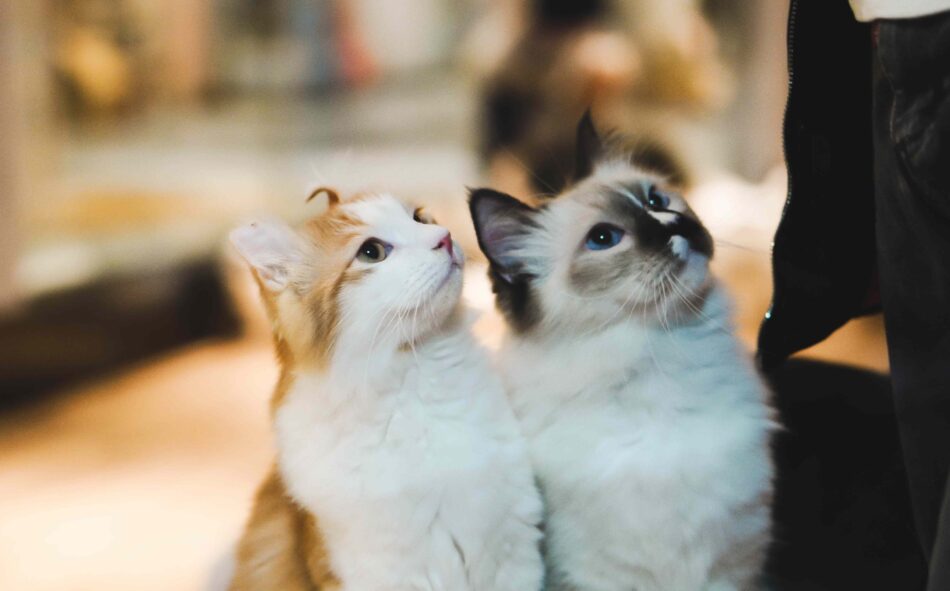
Photo by Kelly on Unsplash
Introducing a new cat can be a difficult time for you and your already existing pet, but fortunately, it’s not impossible to make multi cat households work. So after a bit of advice, hopefully the transition period will be a lot easier. However, should you notice any signs of aggression between your cats, it’s important to seek help from a veterinarian before these issues get out of control.
This entry was posted in Cats
Omlet launch customisable indoor cat tree system
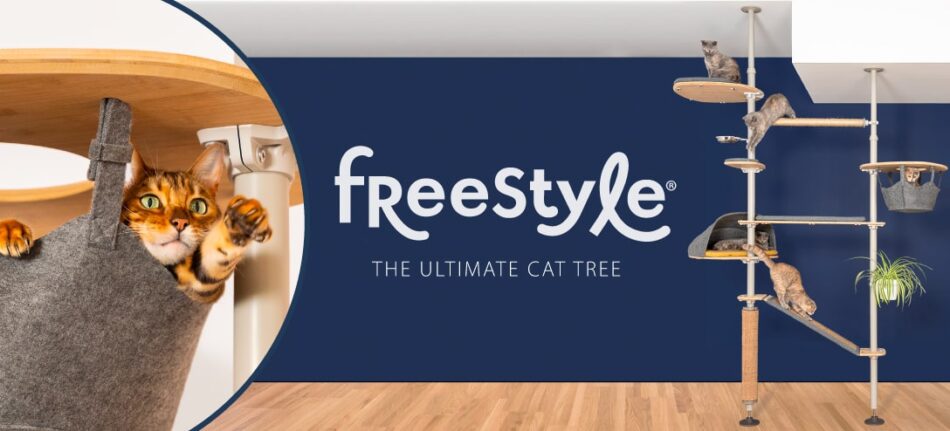
There are an estimated 12.2 million cats in the UK, and numbers have increased significantly after a year of lockdown. The majority of UK cat owners view cats as more than just pets, but as an important and loyal source of happiness, affection and love. With all they do for us, the least we can provide them with is a way to let them be exactly what they are meant to be – cats!
According to the annual PDSA Paw Report, obesity is seen as one of the top 5 welfare concerns for cats by veterinary professionals, and it’s estimated that a shocking 39 to 52 percent of cats in the UK are overweight or obese. Most of these are indoor cats who are limited in terms of exercise and movement, which often leads to frustration and behavioural problems, as well as health issues.
As a nation we clearly need to get these tubby tabbies moving, and Omlet has got the perfect solution!
The new and innovative Freestyle Cat Tree is a floor to ceiling, completely customisable cat play system available with a wide range of fun accessories that will encourage cats to live out their natural behaviours – jumping, climbing, grooming, stretching and scratching, as well as a fair bit of serious relaxing. By providing an irresistible opportunity to exercise and explore, Omlet hopes that cats will be able to find the joy in playing that they might have lost after years of rickety scratching posts and dull fluffy toys.
Even the laziest of cats won’t be able to resist exploring this amazing play system, which in combination with a well balanced diet will make them lighter and leaner, healthier and happier!
The Freestyle Cat Tree centers around strong, extendable vertical poles that can be accessorised with platforms, steps and scratching posts, and connected with ramps and bridges. It’s got everything cats need, including optional dens or hammocks where cats can hide away from the world and properly relax. As an added bonus, it will look great in any home, and can be adjusted in numerous ways to allow cat owners to cater to their pets’ needs.
Omlet’s Head of Design, Simon Nicholls, said: “We wanted to acknowledge that not all cats are the same and create a cat tree that was customisable and extendable over time, and that could provide indoor cats with everything they needed. The versatility of this product is truly unique and we can’t wait for cats around the world to explore it!”

This entry was posted in Cats
While the kids are away, the pets will play!
Start the new school year with 20% off selected Back To School Buys when you spend £30 on qualifying items. Look out for the pencil symbol on out website to find all the included items, or choose some of out favourites ✏️
Terms and conditions
This promotion is only valid from 02/09/21 – midnight on 06/09/21. Use promo code BACK2SKWL at checkout to get 20% off when you spend £30 on selected products. While stocks last. Must spend £30 on items displaying on the website with pencil icon for 20% off to work. Subject to availability. Omlet ltd. reserves the right to withdraw the offer at any point. Offer cannot be used on delivery, existing discounts or in conjunction with any other offer.
This entry was posted in Budgies
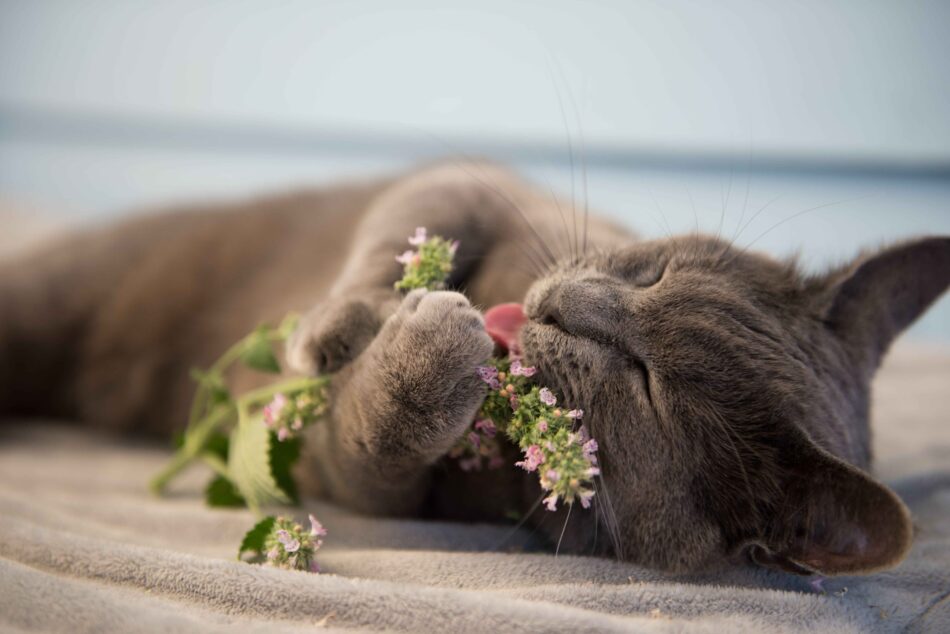
What Is Catnip?
Whether or not you’re familiar with cats, you’ll likely have heard of catnip. Renowned for sending cats “crazy”, catnip is actually a member of the mint family that also goes by the name of Nepeta cataria. The plant grows in Europe, Asia, Africa, and North America, containing nepetalactone, an oil, or chemical compound, found within the catnip’s leaves.
When cats sniff catnip, the nepetalactone enters their nasal tissue, sending signals to the brain. This stimulates sensory neurons, targeting receptors that usually result in behavioural changes. As your cat reacts to the herb, you may witness them shaking their head, licking, rubbing, leaping, or rolling around. Their behaviour can also mimic a cat being in heat, even for male cats, with others displaying feelings of euphoria through being overly affectionate, relaxed, or playful.
How Can I Use Catnip?
Catnip is widely available in a number of forms. Although you can use the plant directly in its fresh, natural state, most commonly, catnip is found dried, or flaked. This can be used on anything including toys, bowls, or simply be scattered around your home. Alternatively, you can purchase catnip spray to spritz onto your cat’s favourite things. Catnip toys are also very popular, with the herb being used in a number of different types of toys including the Omlet’s collection of ocean-themed Maya Cat Toys. However, don’t worry if your cat isn’t too keen on catnip, the toys are also available without.
Why Do Some Cats Not Like Catnip?
Seventy percent of cats will show some reaction to the plant, and whilst most go wild for the stuff, others simply aren’t interested or won’t respond to catnip. This isn’t anything to be concerned about and may be for two reasons. The first being that your feline friend lacks the gene that makes them responsive to catnip. The catnip response is hereditary, relating to the autosomal dominant gene which, interestingly, is not exclusive to domestic cats. Also found in big cats such as lions, fascinatingly, they too can be affected by catnip with effects lasting for up to an hour, compared to a reaction usually only lasting for up to fifteen minutes with our domestic cats!
Equally, your cat’s age may be another reason as to why they seemingly do not like or are not interested in catnip. Catnip is not harmful to kittens, however researchers have found that kittens under eight weeks old show no reaction to catnip. Cats usually show signs of whether they’ll be a catnip lover or not by the time they reach around six months old.
Benefits of Catnip
Anxiety Reducing
As we earlier discovered, catnip can have a sedative effect on cats. Consequently, this can help with their stress levels and in turn, work as a natural form of anxiety relief.
Pain Relief
Research suggests that cats may actually benefit from catnip as pain relief. The plant has the potential to work as a short term solution for cats with muscle pain or arthritis, similarly to how aspirin or paracetamol works for humans.
Encourages Play
With cats often becoming highly energetic after interacting with catnip, this encourages play and exercise, even more so with catnip toys that are bound to give your cat hours of enjoyment. If your cat is particularly playful, they’ll have great fun chasing around the Maya Cat Wand Toy with catnip, and the detachable wand makes it easier for you to raise the toy up high.
Can Help With Bath Time
If you’ve got a cat that doesn’t love bath time quite as much as they love catnip, then adding catnip to their bathwater might make things a lot easier for the both of you. Catnip can make a bath a lot more appealing for your pet, which you can do by adding up to a teaspoon of flakes to boiling water, allowing it to soak, and then putting it into the bath.
If you do decide to give your cat a taste of some catnip for the first time, you’ll want to initially start off with a small amount to gauge their reaction. Should your cat respond well, you can continue to incorporate it into their routine up to a few times a week. Fortunately, catnip is a completely safe product and your cats will not be able to overdose from it. At worst, your cat may experience some digestive issues, however, most cats will let their owners know when they have had enough by refusing.
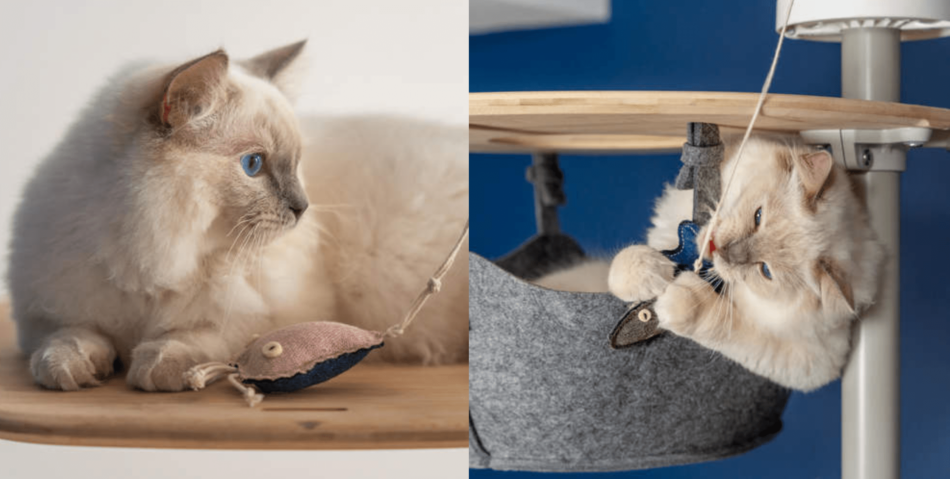
This entry was posted in Cats
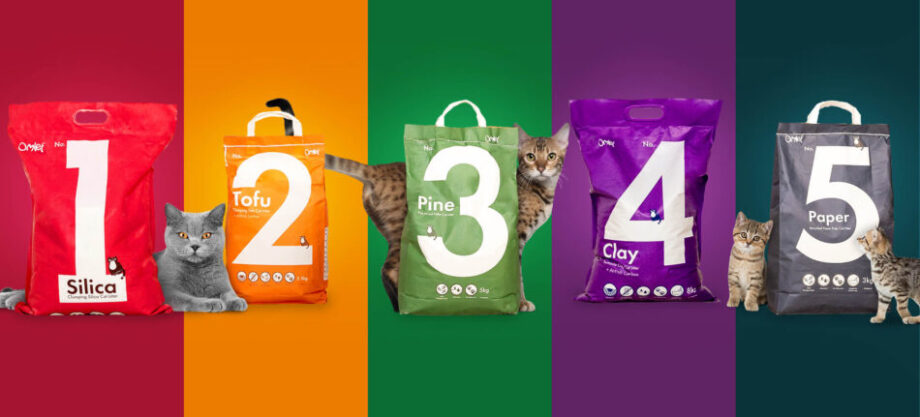
Choosing the right litter for your cat is an important decision but with so many different types of cat litter out there, it can sometimes be overwhelming to know which to go for! Cats can be very fussy animals, even when it comes to their litter boxes, so when choosing which litter to invest in, you’ll need to take both you and your furry friend into consideration. Clay and pine cat litters are popular choices – but which is best for you and your pet cat?
What is Clay Cat Litter?
Clay cat litter was one of the earliest cat litters to be used. Traditional clay litter is formed when clay is crushed, dried in a kiln, and then crushed again to form the litter as we know it to look. To make a clumping clay cat litter, bentonite clay is added to the mix, which absorbs liquid, or your cat’s urine, once it has been detected.
What is Pine Cat Litter?
Pine cat litter on the other hand is made from either wood pulp, or recycled pine shavings, that are then shaped into pellets. This type of litter has a natural wood aroma and can either come as a clumping litter or in non clumping form.
Now that we have established what the main difference is between these two types of litter, we can start to consider what other factors need to come into play when you decide on either clay or pine.
Scent and Odour Control
A lot of clay litters are artificially scented, so if you want more of a natural smell, a pine litter is probably best for you. Furthermore, some cats can be easily irritated by the artificial scents that a lot of clay cat litters have, which can sometimes simply be masking odours, making it near impossible to get rid of litter box odours entirely. If you and your cat prefer a more freshly chopped wood scent, then you’ll love the Omlet Cat Litter No. 3 – Pine, that naturally helps to reduce litter box odours such as ammonia thanks to its absorbent properties. However, if a clay litter is more to your taste but your cat is prone to irritation, unscented clay cat litter is also available. This might be a better option for your cat if you notice a scented clay litter resulting in allergies or your cat refusing to use their box.
Texture
Of course every cat is different, but particularly fussy cats will likely prefer a fine-grained litter texture. Clay has this advantage over pine, which some cats do not get along with, as the granules are slightly larger than the sand-like texture that clay offers. In the outdoors, cats like to bury their waste in sand so the closer their litter can replicate this, the better.
Clumping
Many clay litters are clumping, which means that they form clumps when coming into contact with liquid. This is because of the type of clay that is added to the formula (bentonite). Clumping clay litter, as opposed to a clay non-clumping litter, is what you’re most likely to find on the market as it makes for a much easier cleaning process of the litter box. Although pine is highly absorbent, it simply does not clump quite as well as clay does.
Dust
Dust can become a real issue with some cat litters. When litters are handled or in transit, it almost becomes inevitable that the pellets will rub together which then forms a dust. Many cat owners notice this dust when pouring the litter into their cat’s litter box. Although it may seem harmless, litter dust can in fact become harmful for both humans and cats, causing respiratory problems in the long run. Pine litters are generally better than clay when it comes to producing the least dust. They are a low dust cat litter option, which also means a better choice for cats with allergies or sensitivities.
Environmental Impact
If a more environmentally friendly option is what you’re on the lookout for, then a pine litter will be a much better choice for you. Being a natural litter made up of wood pulp, pine is a renewable and biodegradable material. Alternatively, Omlet’s Cat Litter No. 4 – Clay offers a low waste clay litter solution that is less taxing on the planet than traditional non clumping clay cat litter, which can often create more waste, as cat owners can unknowingly end up frequently disposing of fresh litter. Omlet’s clumping clay cat litter means less waste for you, as clumps appear once the litter box has been used by your cat, making it super easy to scoop.
Other Litters to Consider
Pine and clay cat litters are just two of the many litter options out there. Omlet stock a range of different types of cat litter that might be a better fit for you and your cats.
If dust is becoming a problem with your current litter, how about switching to Omlet’s Cat Litter No. 5 – Paper. As previously mentioned, many types of cat litter produce at least some amount of dust. However, the Omlet paper cat litter is virtually dust free, with the biodegradable pellets being made from recycled newspaper.
Natural litters such as grass are growing in popularity. Grass cat litters are a newer product on the market and are made using grass seeds. This litter is extremely lightweight, offers good odour control, and is also scent free.
Omlet’s Cat Litter No. 2 – Tofu may be one that you’ve not heard of just yet, but with highly absorbent properties and being more of an eco-friendly candidate, it might just be the right litter for you and your furry friend. Made from 100% crushed tofu, tofu cat litter stays fresher for longer with its active carbon composition.
Silica gel litter, also known as crystal litter, is a silica based cat litter. Made from silica crystals, it has the amazing ability to absorb a large amount of liquid. Another newer cat litter that has become available, dust from silica gel litter is also practically non-existent. Take a look at Omlet’s Cat Litter No. 1 – Silica.
After reading how clay and pine cat litters differ and learning a bit more about what else is available, hopefully you’ll now be one step closer to making your final decision on which one is the perfect match for your pet!

This entry was posted in Cats


























 With the new Cosy Collection, there are six new amazing
With the new Cosy Collection, there are six new amazing 





 Whilst cats can be great companions, most love having their alone time too. This is because cats are solitary predators, meaning that they hunt alone as opposed to in packs like our canine furry friends do. Cats will also establish their own territory via spraying, ‘claiming’ an environment as their own, which is somewhere they should be left undisturbed. This is why it’s a good idea to invest in an
Whilst cats can be great companions, most love having their alone time too. This is because cats are solitary predators, meaning that they hunt alone as opposed to in packs like our canine furry friends do. Cats will also establish their own territory via spraying, ‘claiming’ an environment as their own, which is somewhere they should be left undisturbed. This is why it’s a good idea to invest in an 
 There are a number of different areas in your home that may be appropriate to place your cat house. This depends on your living situation, and your cat’s preferences. Do they like to be involved with family time or would they prefer to have their shelter in their own quiet room? As we earlier mentioned though, if you have outdoor cats, it’s not recommended that you place your
There are a number of different areas in your home that may be appropriate to place your cat house. This depends on your living situation, and your cat’s preferences. Do they like to be involved with family time or would they prefer to have their shelter in their own quiet room? As we earlier mentioned though, if you have outdoor cats, it’s not recommended that you place your Are you struggling to find the purrfect Christmas present for a cat lover you know? Rest assured, you’ll be bound to find something at The Omlet Christmas Market! A number of cat toys and accessories are on offer this year so you’ll want to hurry to ensure you won’t miss out on some unmissable savings!
Are you struggling to find the purrfect Christmas present for a cat lover you know? Rest assured, you’ll be bound to find something at The Omlet Christmas Market! A number of cat toys and accessories are on offer this year so you’ll want to hurry to ensure you won’t miss out on some unmissable savings!





















